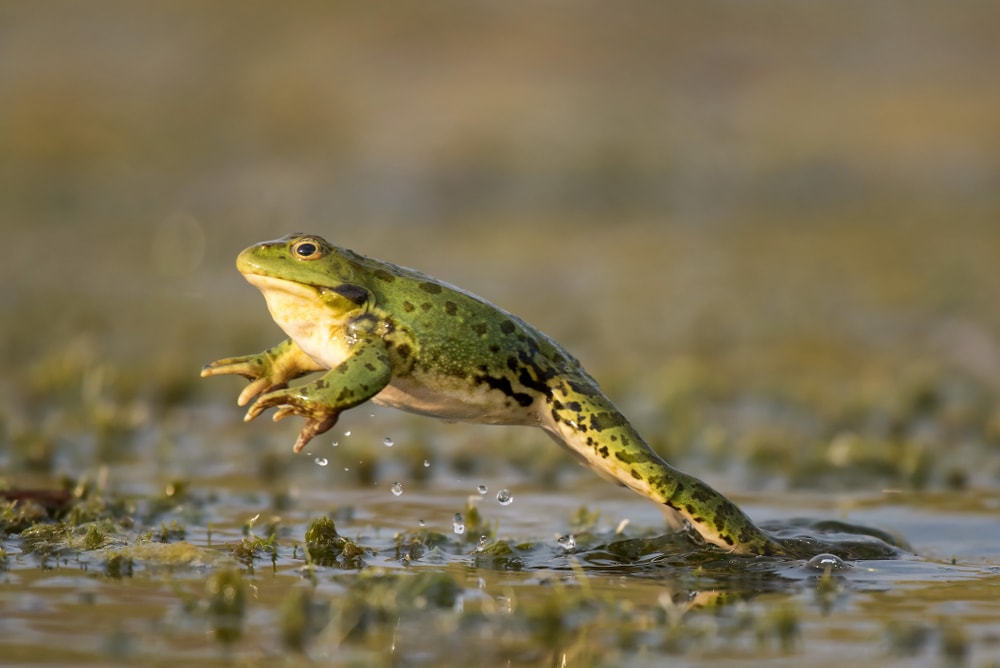
In Spring, Michigan resonates with the sound of birds chirping, bees buzzing and light spring showers. If you listen closely, you can also hear frogs and toads chirping and trilling.
Michigan is home to 14 native species of frogs and toads, and two of them are very uncommon; The Blanchard’s Cricket frog and Boreal Chorus frog. Frogs and toads require bodies of water for the majority of their life cycle, and Michigan provides the perfect environment for them, with its many ponds, rivers, swamps and lakes.
In this article, we will explore in-depth the 14 species of frogs that live in Michigan, from habitats, diets and mating calls.
The difference between frogs and toads
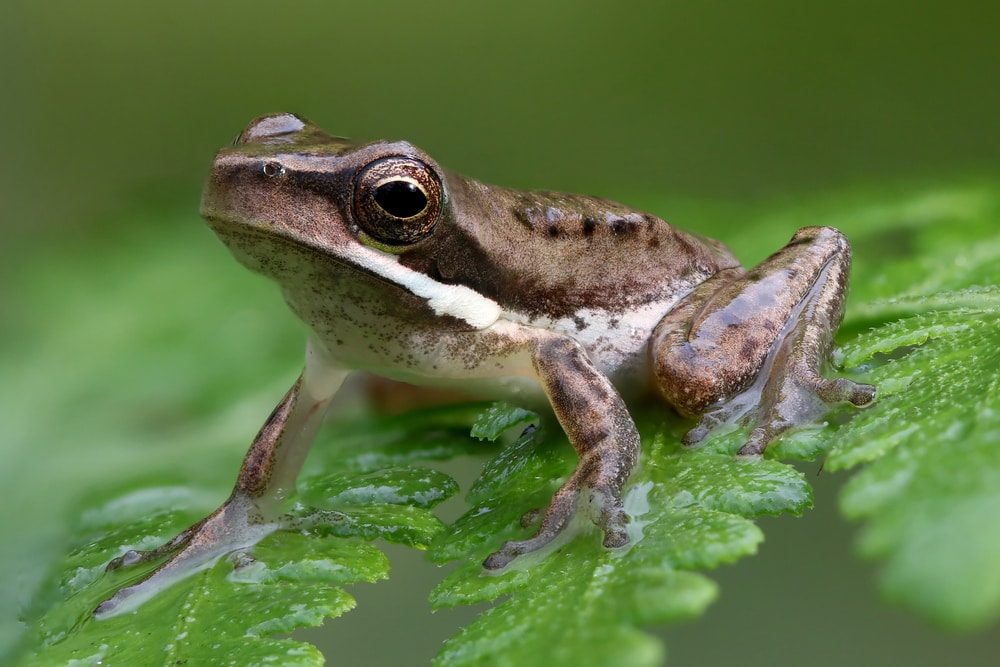
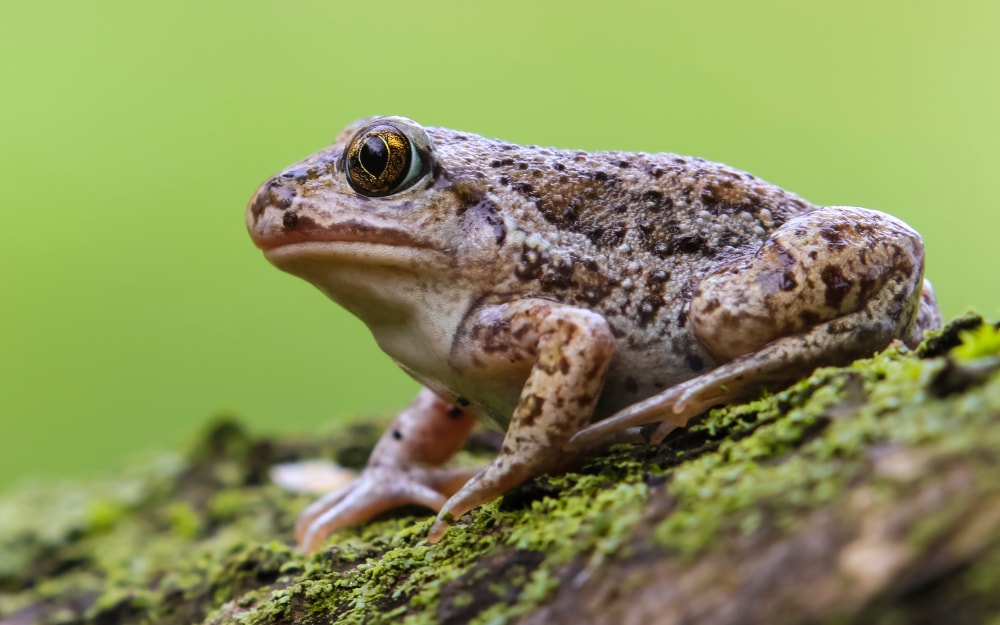
Frogs and toads are amphibians that belong to the group anurans, which means “without a tail”.
The main difference between frogs and toads is the length of their legs. Frogs have long legs and can jump, while toads cannot jump as their legs are short, so they crawl.
You can also differentiate a frog from a toad by its skin. Frogs have smoother skin, while toads look all warty with lumps and bumps. Frogs look constantly wet, while toads have very dry skin.
Frogs need to live near bodies of water because their skin loses moisture very easily. On the other hand, toads can be seen in the grass or on pavement, as their skin deals better with dry conditions.
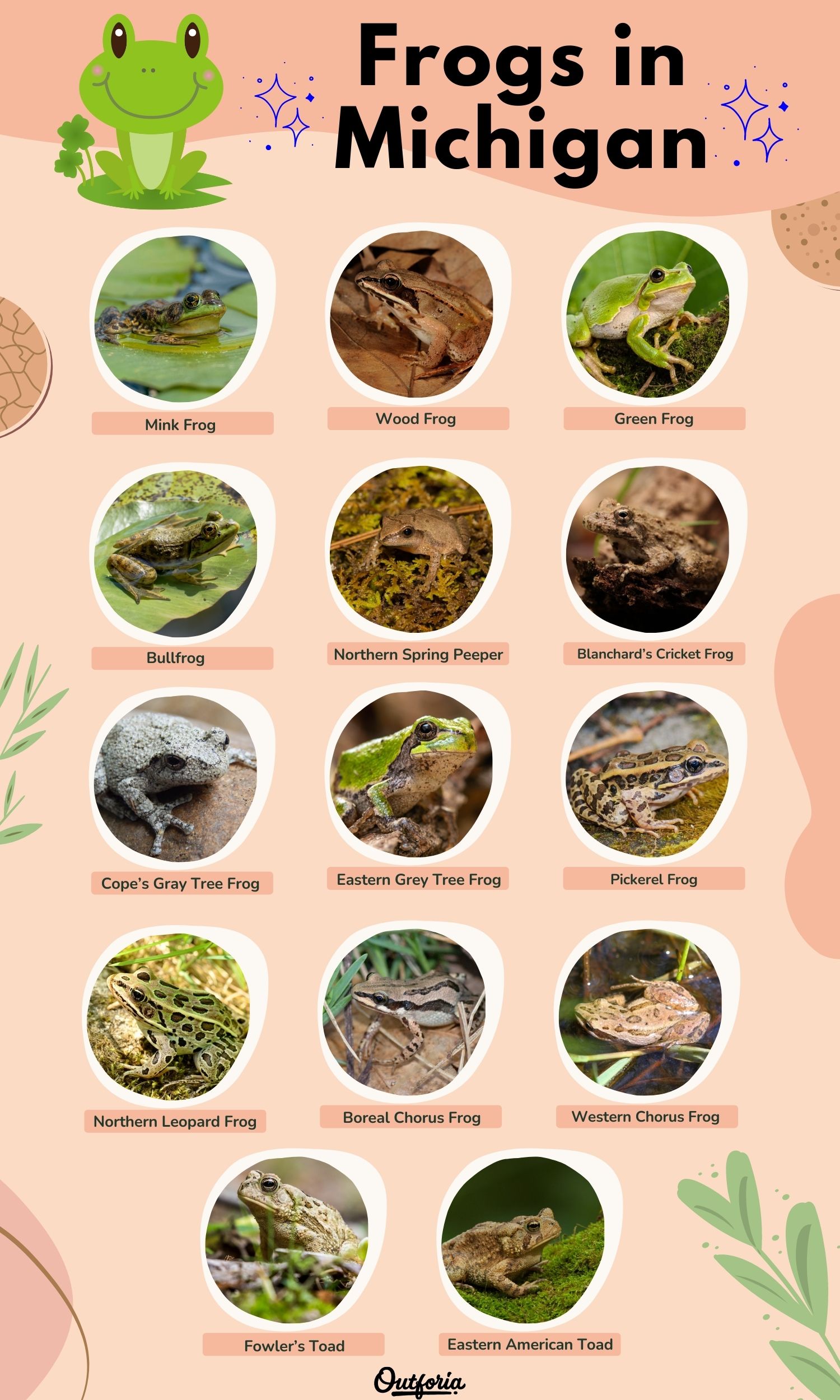
Share This Image On Your Site
<a href="https://outforia.com/frogs-of-michigan/"><img style="width:100%;" src="https://outforia.com/wp-content/uploads/2022/05/Frogs-in-Michigan-infographics-05202022.jpg"></a><br>Frogs of Michigan Infographic by <a href="https://outforia.com">Outforia</a>You May Also Like: 15 Most Common Species Of Snakes In Michigan: Pictures + Facts
All About The 14 Frogs of Michigan
1. Mink Frog (Lithobates septentrionalis)
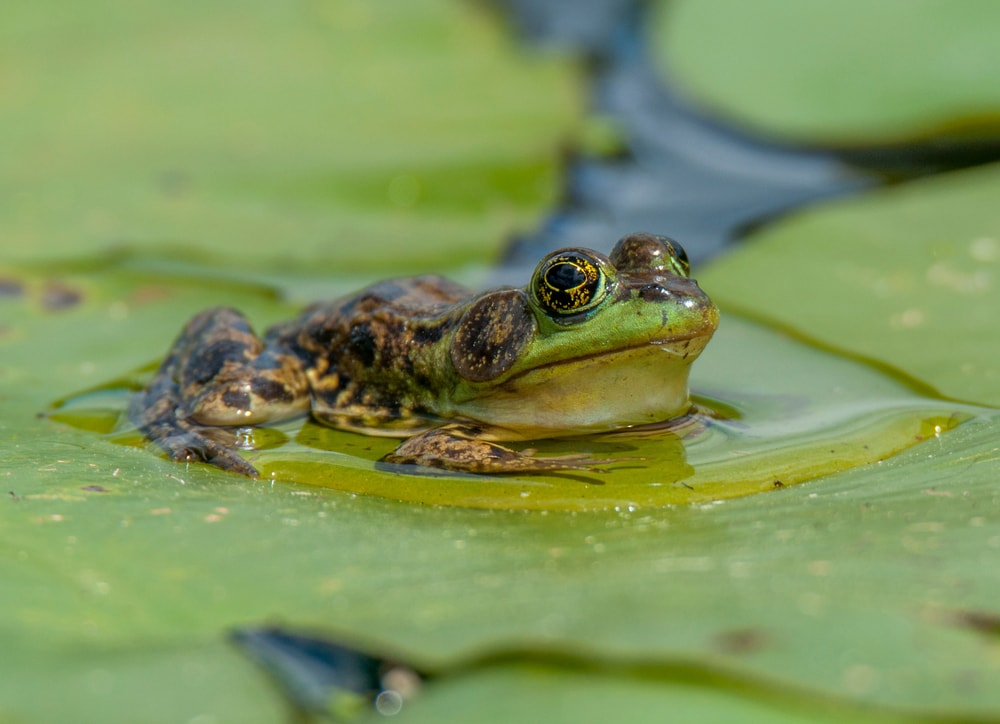
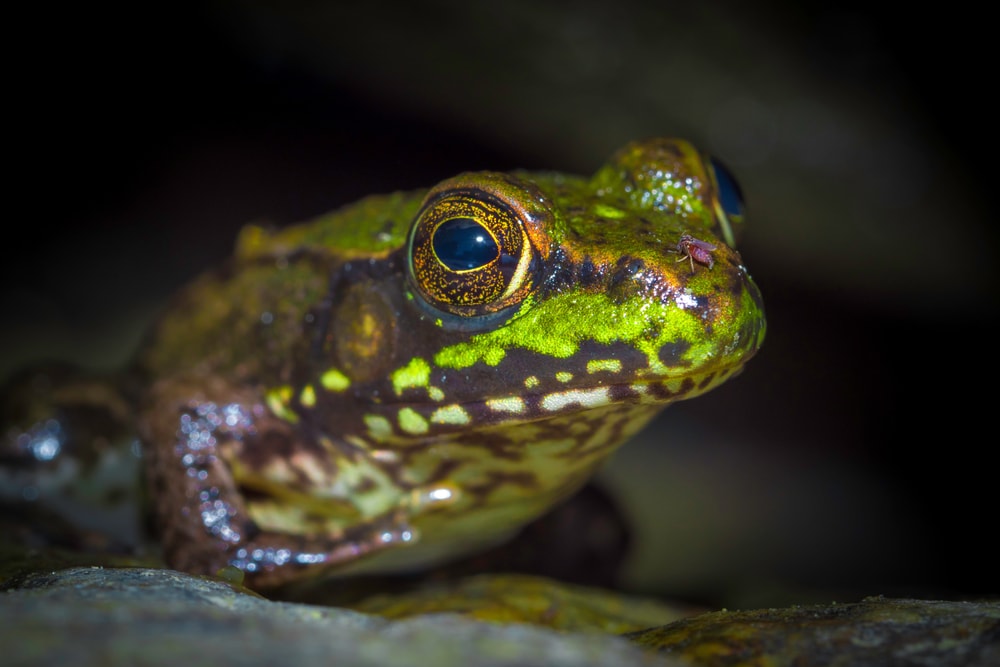
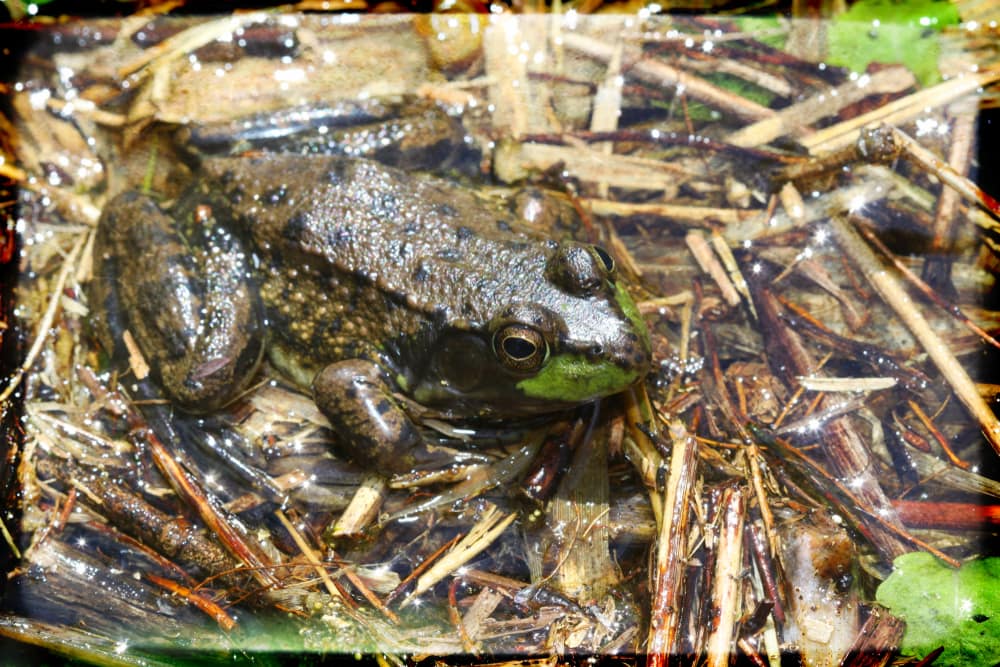
The Mink Frog looks like a marble. It has a green, olive or brown back with irregular blotches. Its belly is white or yellow, and they has webbing on its hind feet. The adult Mink frog can reach up to 3 inches (7.6 cm). This frog can live up to 6 years in its natural environment.
The Mink frog got its name from the odor it releases when people handle it. They smell like rotting onions or minks. This species has a distinct calling that resembles somebody knocking at the door.
Mating season starts with the singing of the male frog, from May until August. The female usually lays between 400 and 4000 eggs underwater. The eggs will eventually sink before hatching.
Their ideal habitat is the wetlands, and they live in ponds, lakes, swamps, streams, in the Upper Peninsula of Michigan. They prefer bodies of water with lots of water lilies to hide from predators.
The Mink frogs are insectivores, and they feed on spiders, snails, dragonflies, beetles, and insects that live on the surface of the water.
2. Wood Frog (Lithobates sylvatica)
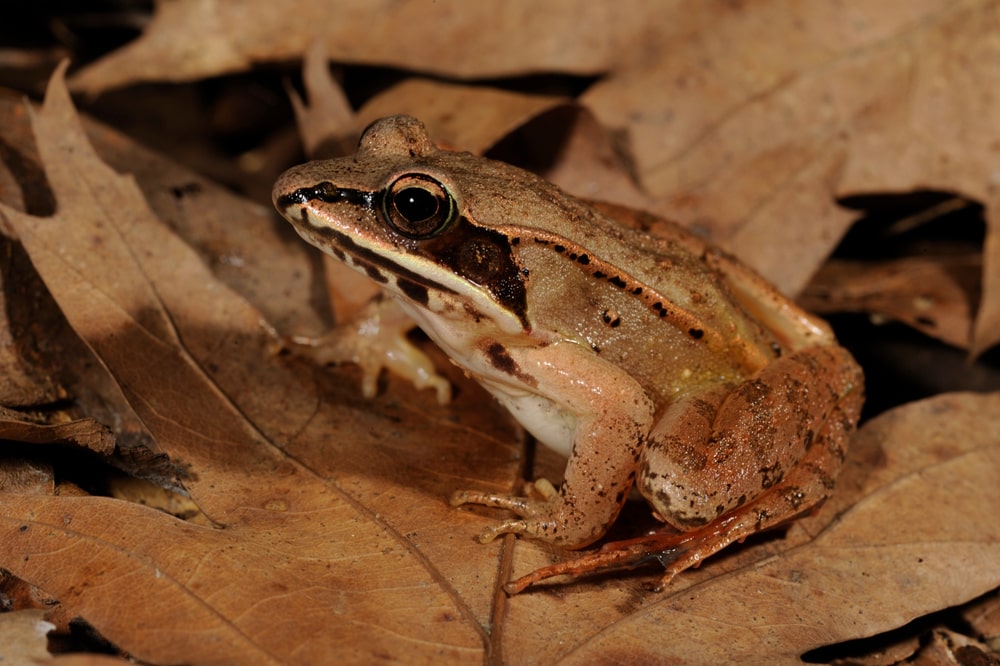
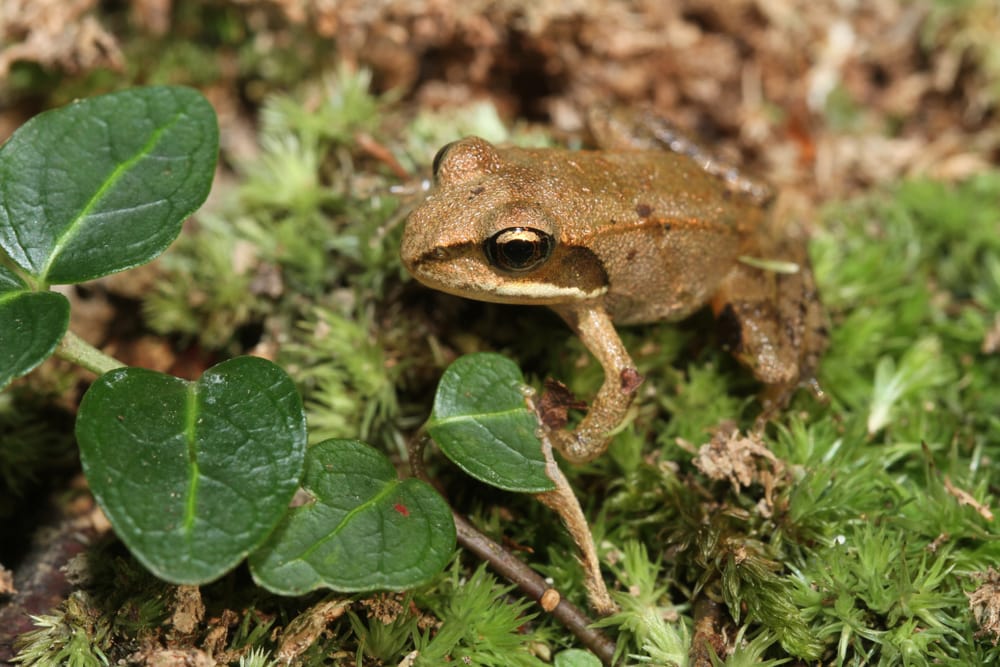
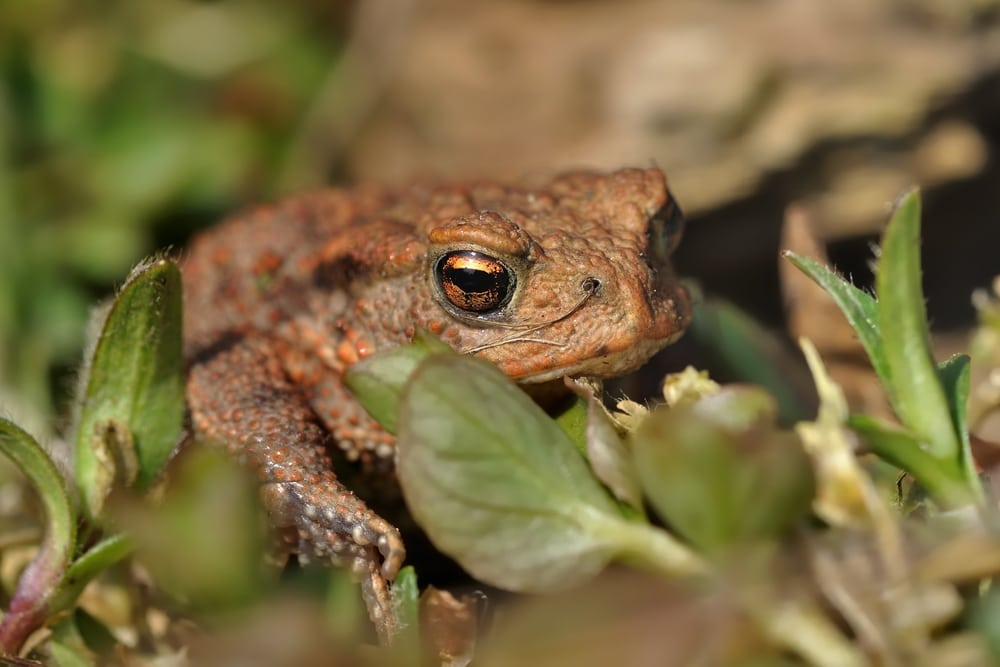
The Wood frog looks like it has a mask around its eyes, like a cartoon character thief. They vary in skin color from brown, tan, green and gray. It is a medium-sized frog, and an adult one reaches 3 inches (7.6 cm). They can live up to 5 years, but males have a shorter lifespan than females.
These frogs have an inventive way of dealing with winter. Their bodies contain an antifreeze called glucose that protects their cells from bursting. Even if plenty of its body fluids are frozen, this frog can survive the winter and resurface during spring as nothing happened.
As their name suggests, Wood frogs prefer habitats of woodlands like thickets, wet meadows, bogs and coniferous or deciduous forests. They are aquatic breeders, so when the early spring mating season starts, Wood frogs gather near ponds.
Males use mating calls to attract females, and they make a quacking sound.
The female lays 1000 to 3000 eggs in the pond. The mass of eggs turns green to camouflage, just like green pond vegetation. It takes between 9 to 30 days for the eggs to hatch.
Wood frogs feed on spiders, beetles, moth larvae, slugs and snails.
Wood frogs do their best to avoid encounters with snakes, herons, raccoons, skunks and minks. Their defense mechanism consists of poisonous skin secretion, camouflage methods, and a piercing cry if they get caught.
3. Green Frog (Lithobates clamitans)
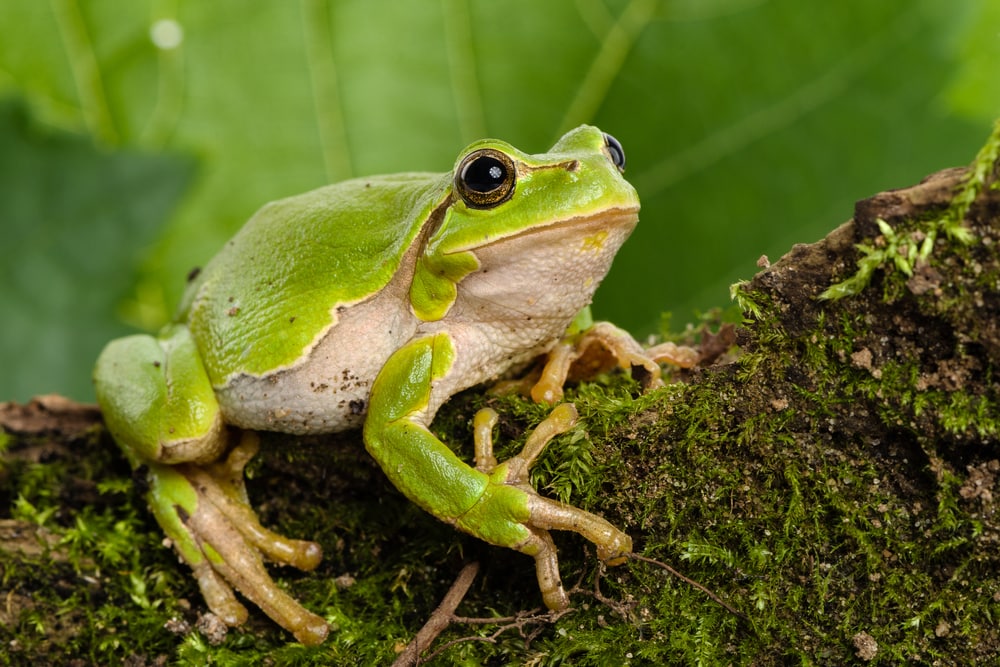
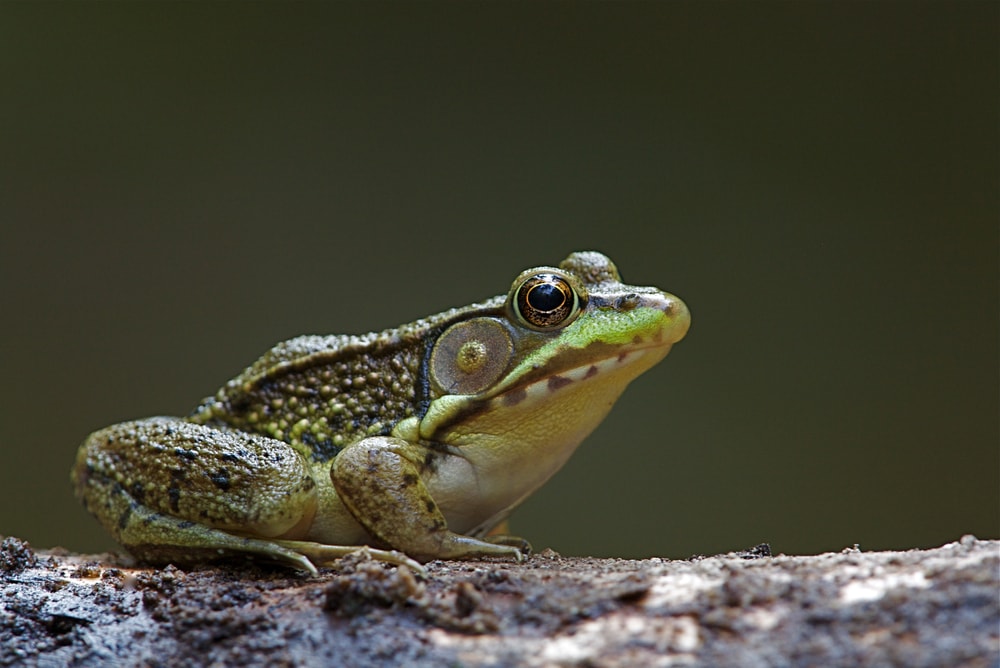
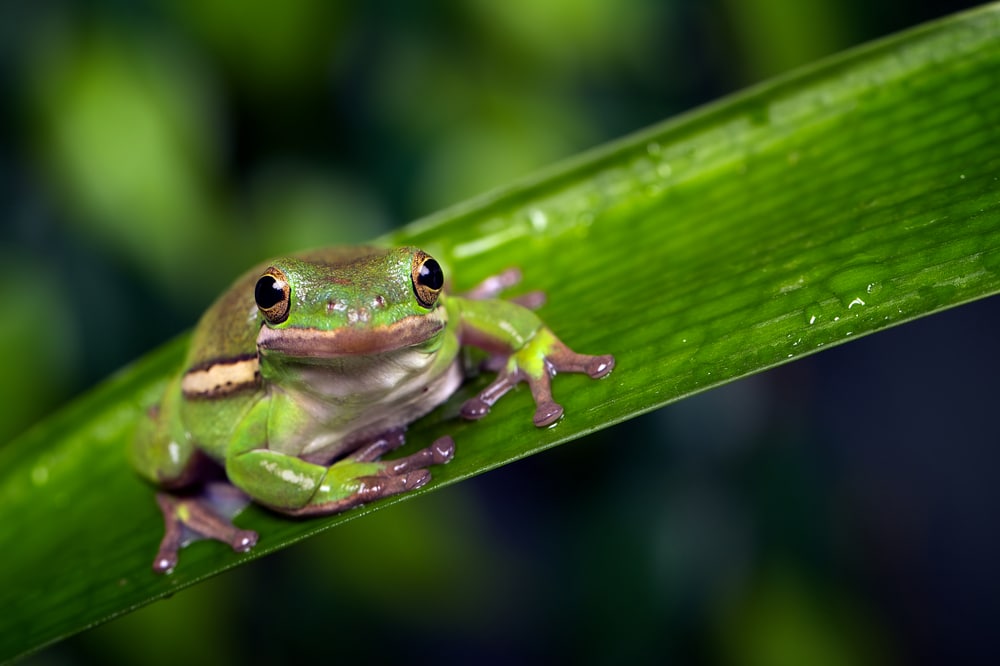
The Green frog is about 4 inches long (10cm), and the females are bigger than males. These frogs can be green or brown, with their backs and hind legs spotted or blotched.
These frogs are the easiest to come across in Michigan as they live in permanent bodies of water like lakes, ponds, swamps, and streams. They usually stay on the shoreline. If they get spooked, they immediately jump into the water.
Their unique call sounds like a banjo string being pulled.
They usually breed from May until August, and the female will lay eggs in places with aquatic vegetation.
The Green frog is an opportunistic feeder, meaning it will eat anything that fits into its mouth. They usually feed on spiders, insects, crayfish, snails and slugs. The tadpoles eat algae and zooplankton.
Like all frogs, their predators consist of snakes, turtles, herons and raccoons. Their defense mechanism is exactly like the Mink frog, which is a loud cry.
4. Bullfrog (Lithobates catesbeianus)
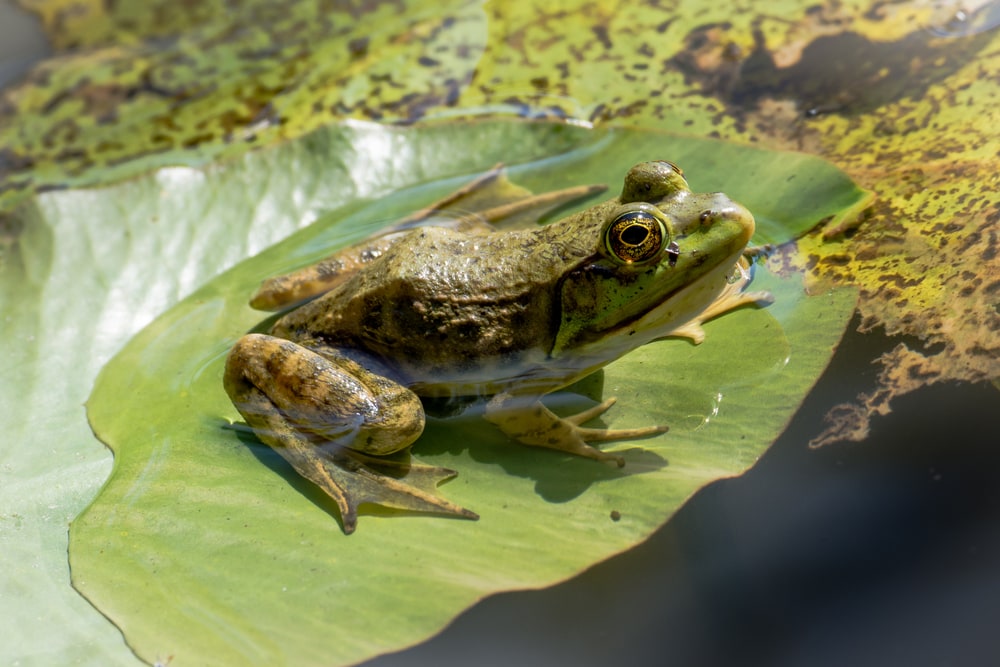
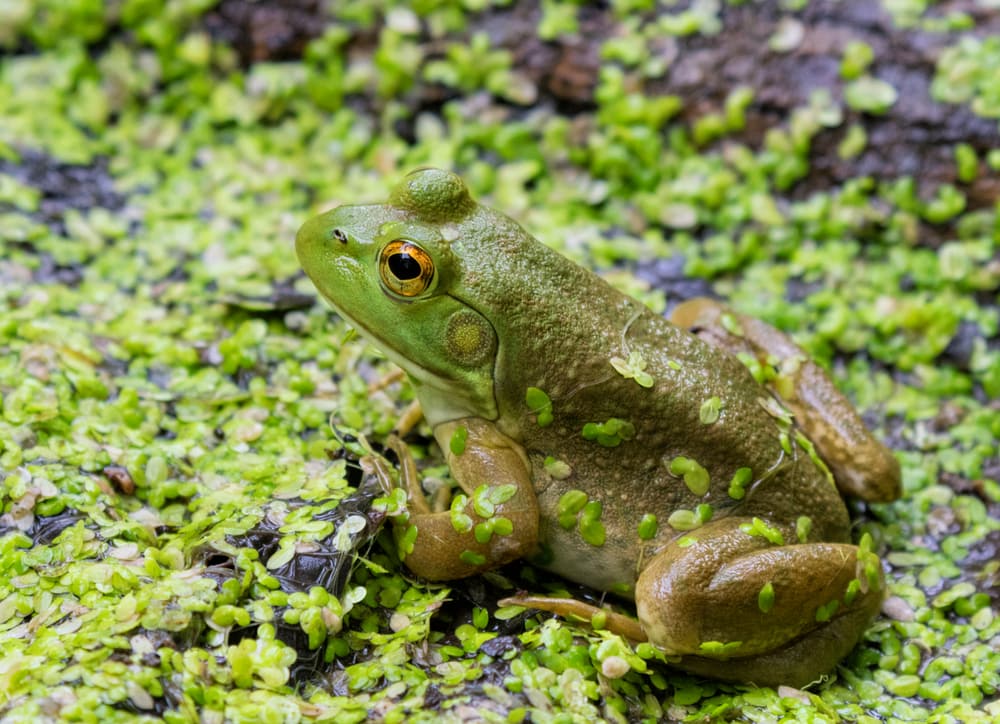
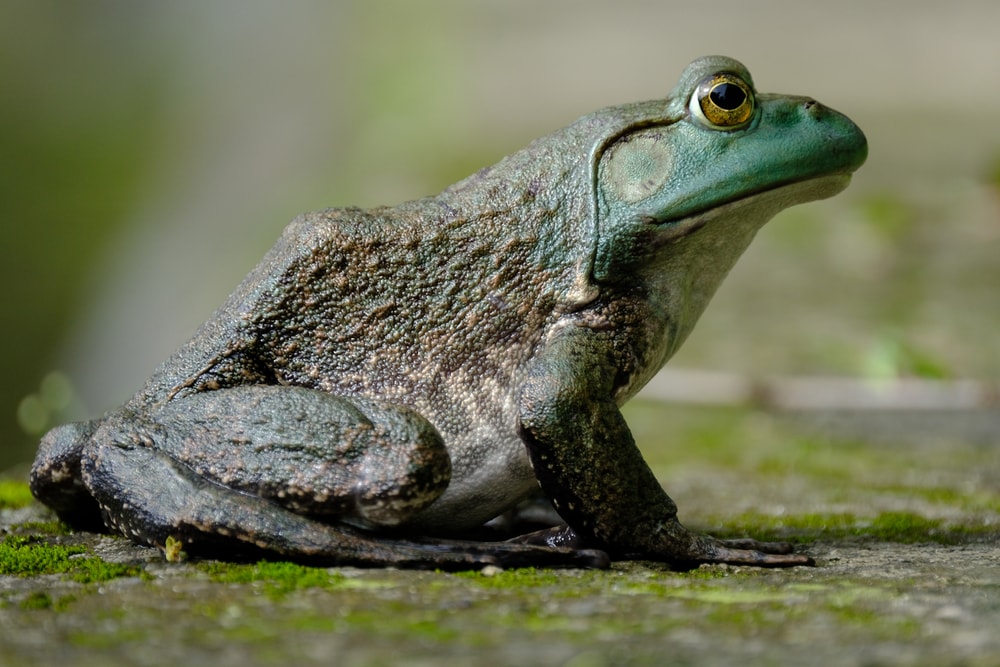
The Bullfrog is the largest in the United States and can reach up to 8 inches (20 cm) and weighs up to a pound (450 g). Its skin color ranges from plain green, gray or brown.
Bullfrogs are highly aquatic, so they live near permanent bodies of water. You can see them near ponds and lakes. In wet weather, they will walk on land at night
These frogs are voracious predators and eat almost anything that fits in their mouths. They feed on other frogs, salamanders, snakes and turtles.
The call of the Bullfrog is a very deep “Jug-o-rum” sound.
They usually mate from May until July, and the female lays between 15,000 to 20,000 eggs.
Metamorphosis is the biological process by which an animal physically matures after birth or hatching. It involves changes in the body’s structure, from an immature form to the adult version, in one or two stages. It takes about three years for the Bullfrog tadpoles to metamorphose and become adults.
The Bullfrog is found all over the western U.S and it is considered a pest species because of its big appetite. This voracious feeder has led to the local extinction of some amphibians and reptiles.
5. Northern Spring Peeper (Pseudacris crucifer)

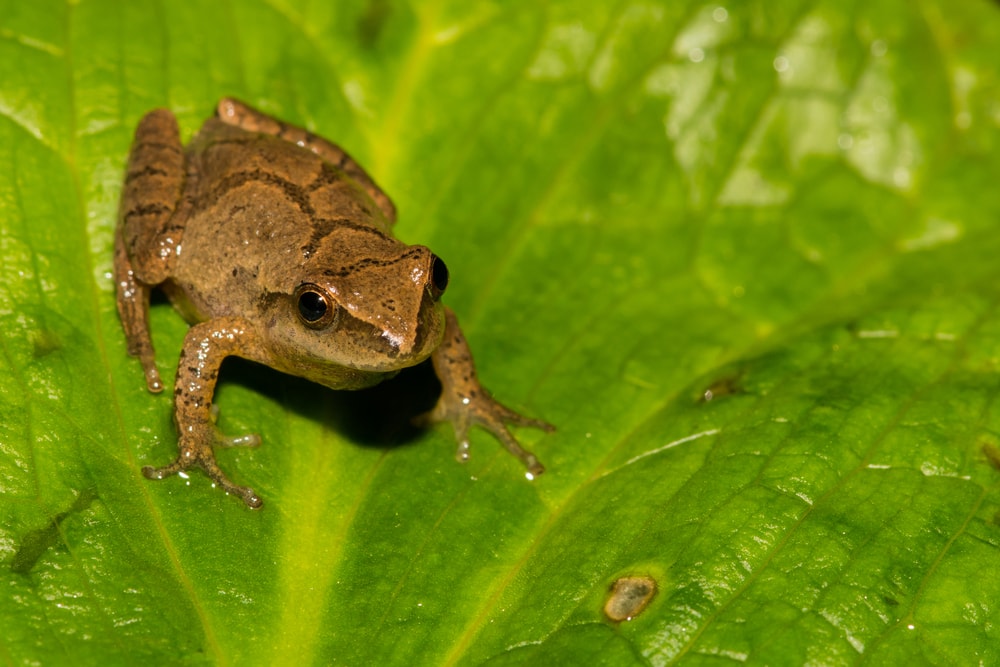
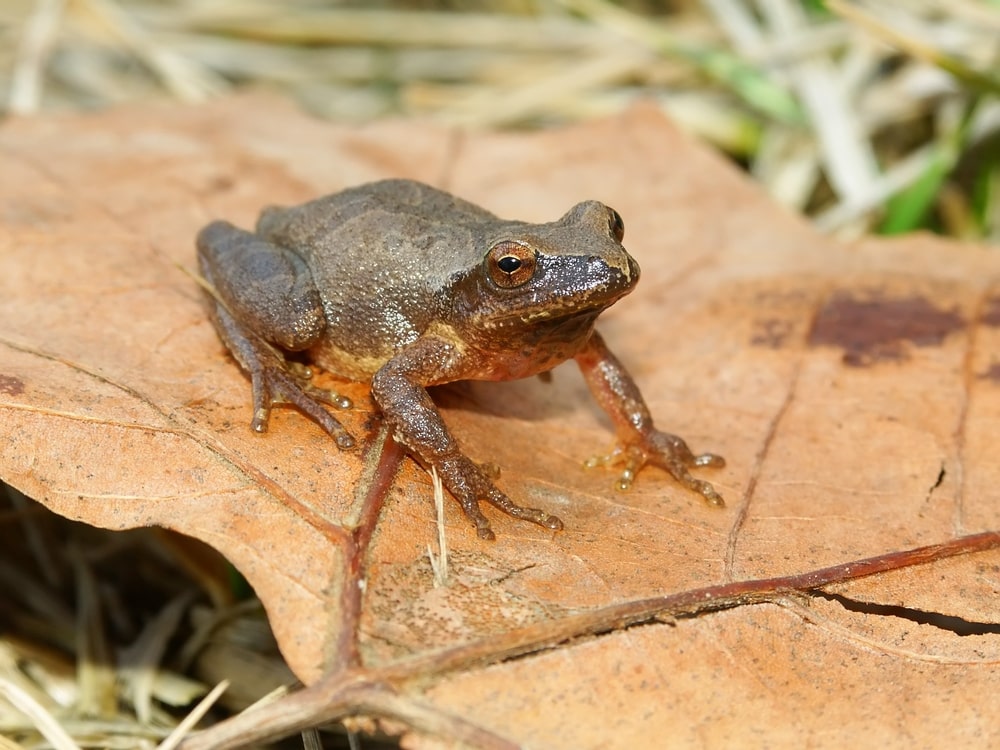
The Northern Spring Peeper is a tiny frog that can reach up to 1.4 inches (3.5 cm) and live up to 3 years. The Spring Peeper comes in many colors, from shades of brown, gray or olive. They can camouflage themselves easily on trees and leaf litter.
These frogs breed in temporary or permanent bodies of water, so their habitats consist of marshy woods, ponds and swamps. Their breeding period starts from April until June, with a very squeaky call.
The female lays 750 and 1,300 eggs, and the tadpoles hatch in 15 days and take 90 days to go through metamorphosis and become frogs.
They mainly eat small insects and arthropods like ants, beetles, flies, mites and spiders.
6. Blanchard’s Cricket Frog (Acris blanchardi)
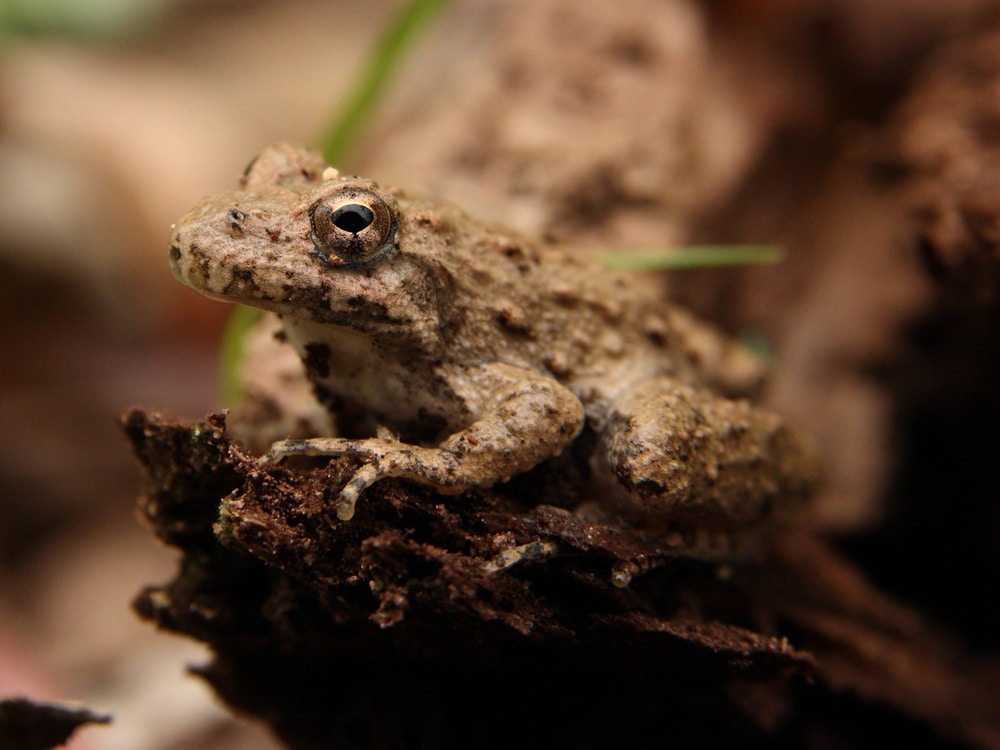
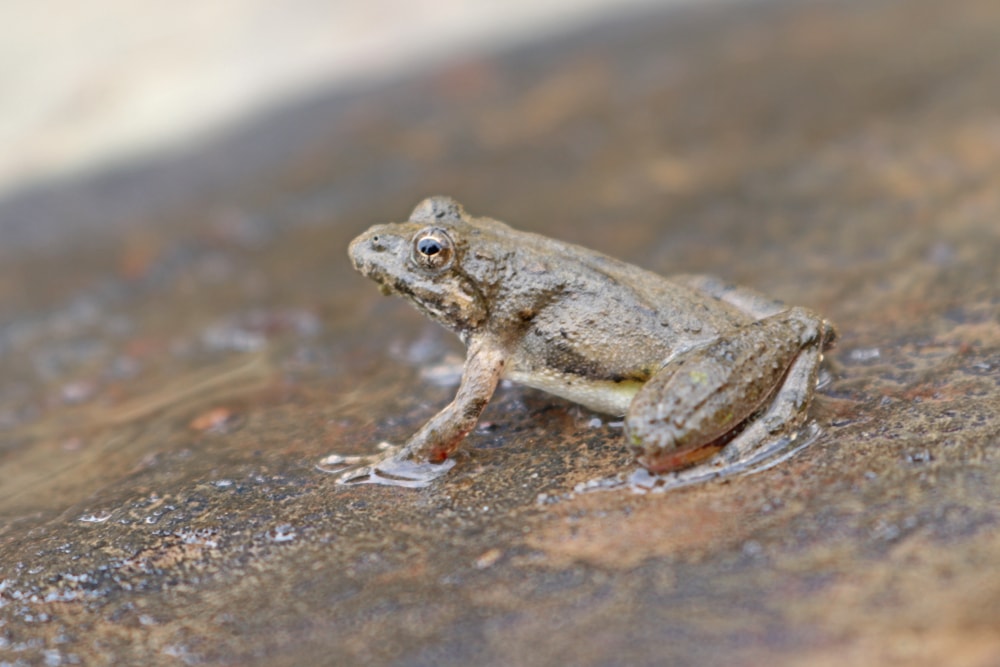
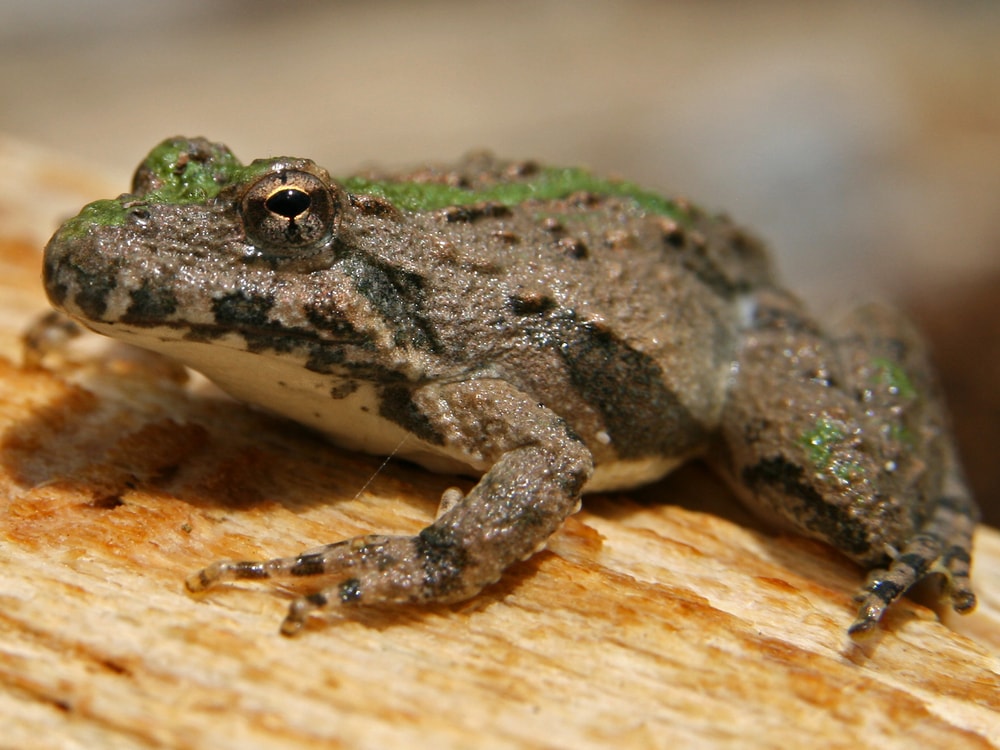
The Blanchard’s Cricket frog is a small frog with a lot of warts. It reaches almost 1.5 inches (3.8 cm) and presents tan, brown, olive or gray colors. On top of their head, you can see between their eyes a triangular mark.
The cricket frog has a very distinct calling sound, much like a metallic click.
Their habitats consist of ponds, lakes, bogs and rivers. This species is the most aquatic treefrog in North America and doesn’t leave the bodies of water unless it’s the rainy season.
This species only lives for one year, and due to habitat loss and chemical contamination, they are a Threatened species, meaning it is legally protected.
7. Cope’s Gray Tree Frog (Hyla chrysoscelis)
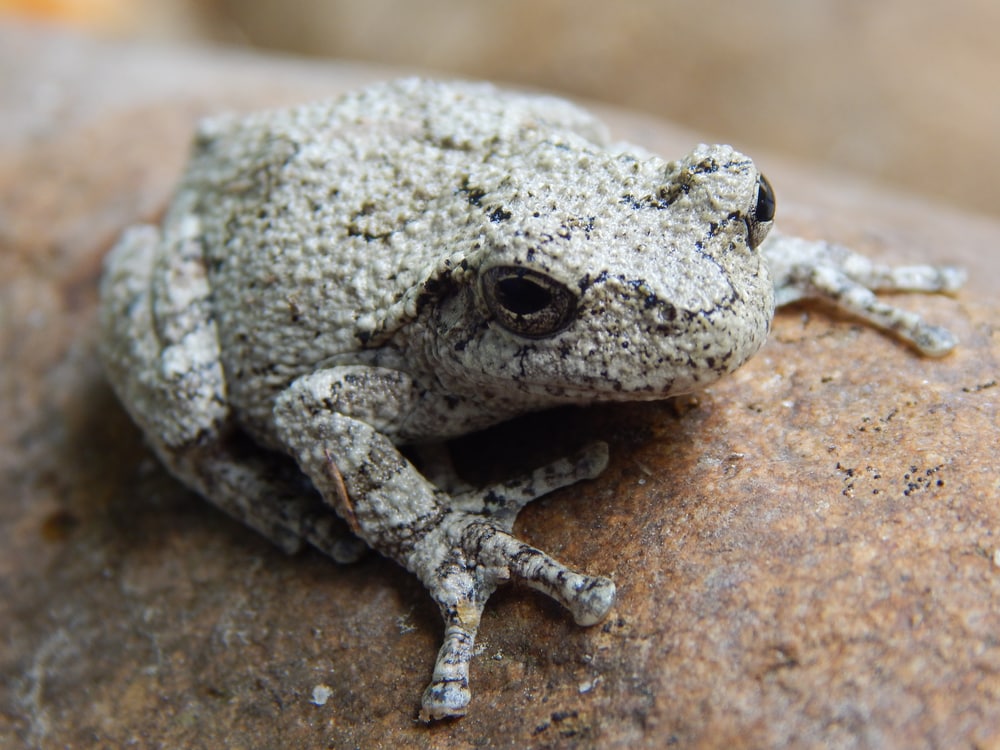
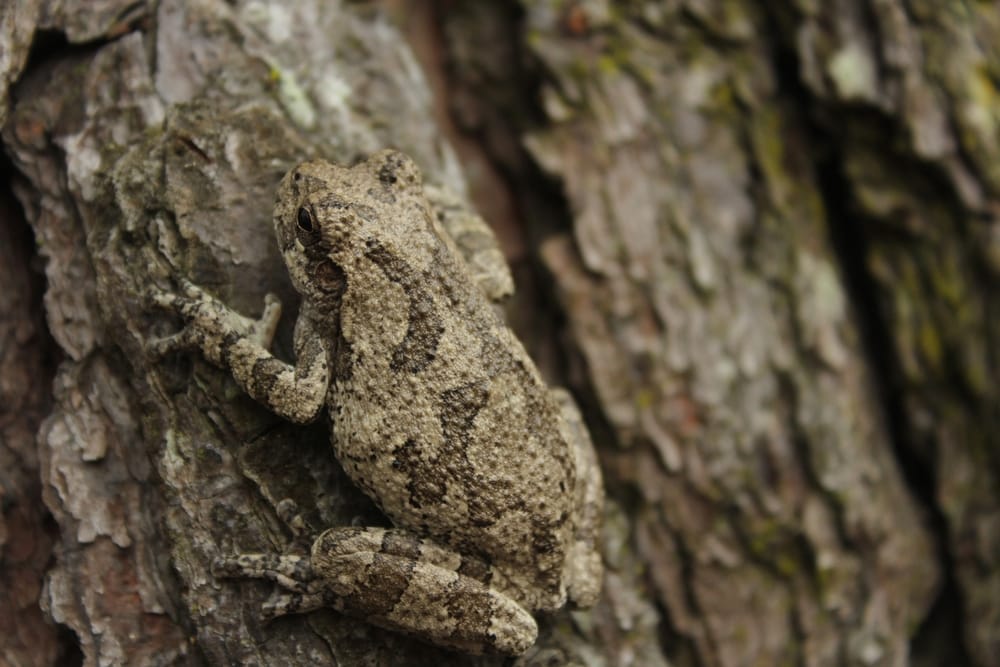
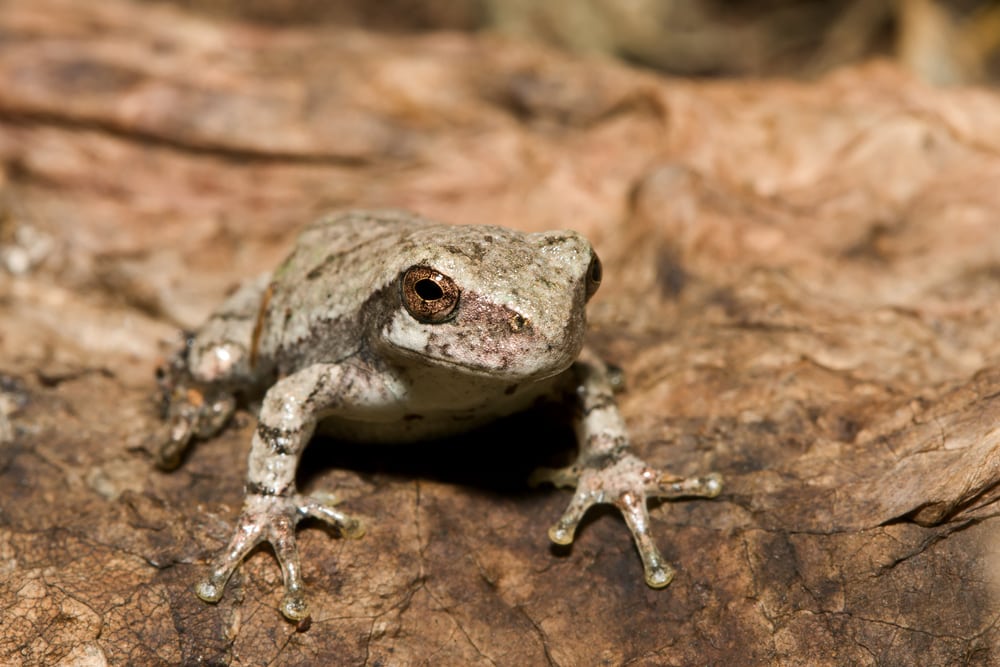
The Cope’s Gray Tree frog is a medium-sized frog that reaches up to 2 inches (5.1 cm) and can live up to 9 years. Their toe pads are very large, and their skin is granular. Their coloring varies from gray to light green, and they have orange inner thighs. They also sport a whitish spot right below their eyes.
This frog has an amazing chameleon-like camouflage defense mechanism. It can slowly blend with its environment. The Grey Tree frog can be seen all over Michigan in wooded habitats like backyards, forests and swamps.
Tree frogs spend their days in trees, and at night they hunt for food, mostly insects. Tree frogs get down from their trees when the mating season begins, from March to August. Their mating call is quite musical.
8. Eastern Grey Tree Frog (Hyla versicolor)
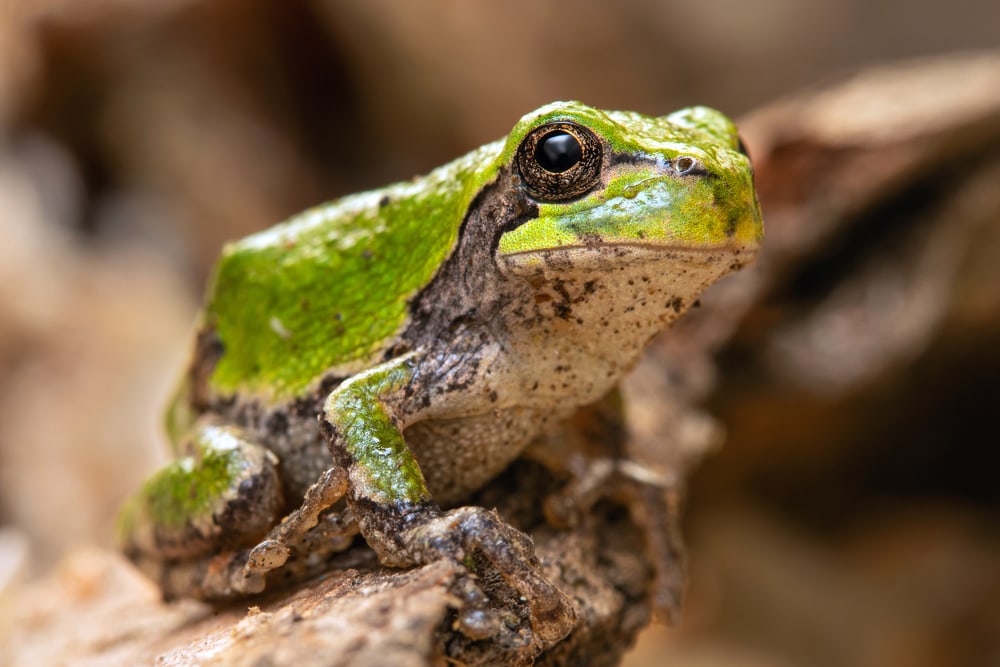
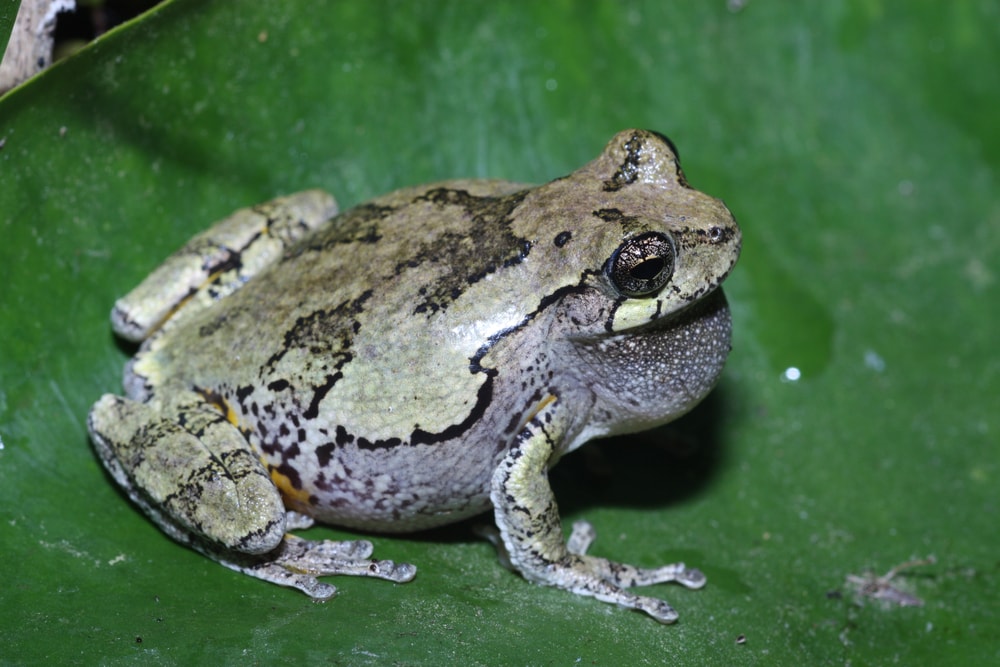
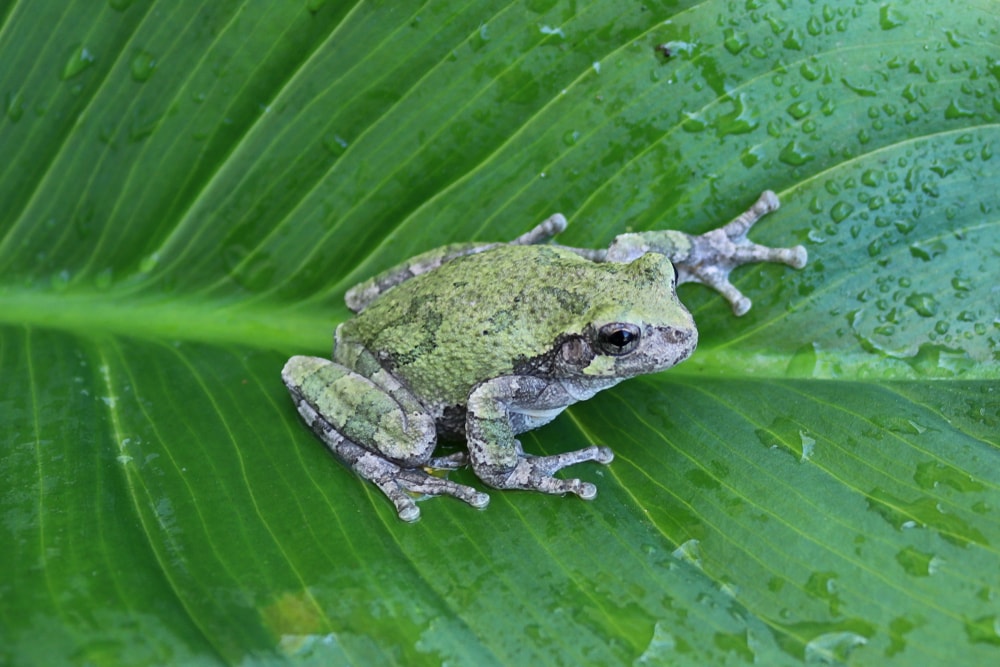
The Eastern Grey Tree frog is quite similar in size to Cope’s frog as it reaches 2 inches (5.1 cm) and lives up to 9 years. The Grey tree frog has twice as many chromosomes as Cope’s frog, and its skin is bumpier.
The coloring varies from green, gray or brown. This species can also change colors depending on temperature. If it is cold or dark, the frog will become darker too. This tree frog likes to live in deciduous woodlands, swamps and near bodies of water.
Due to its sticky toe pads, this frog is a great climber, and it finds its prey in trees. They feed on moths, tree crickets, ants and flies.
Their breeding period starts from April until August when males gather in trees and start calling for females.
The female will select her partner based on its call, and she will lay up to 2000 eggs on the surface of ponds. The tadpoles hatch in 5 days and become frogs in two months.
9. Pickerel Frog (Lithobates palustris)
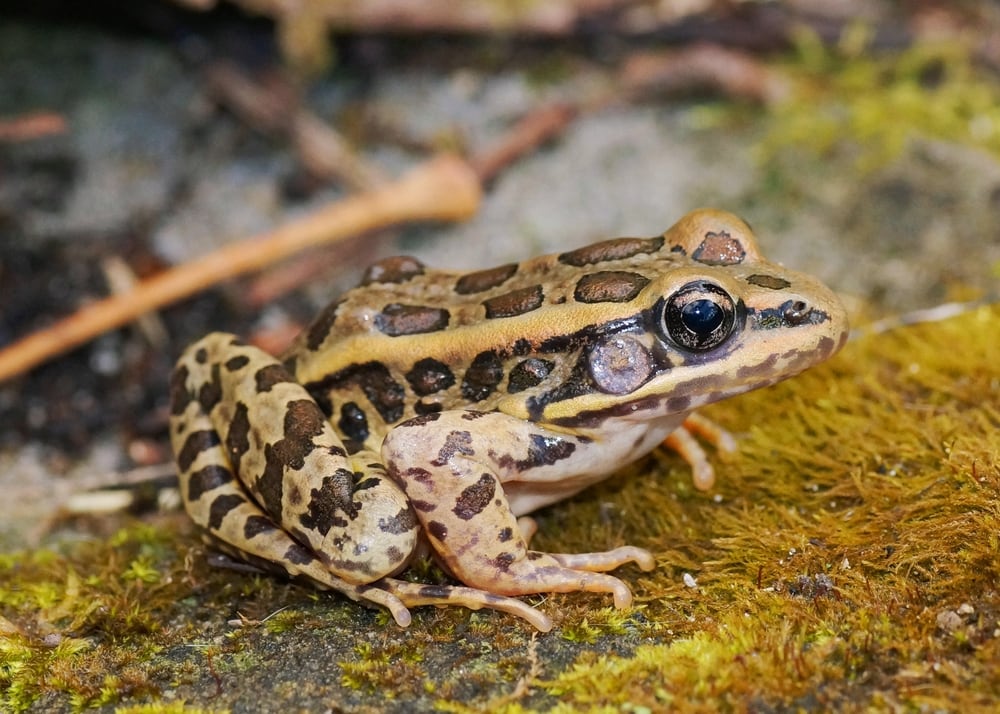
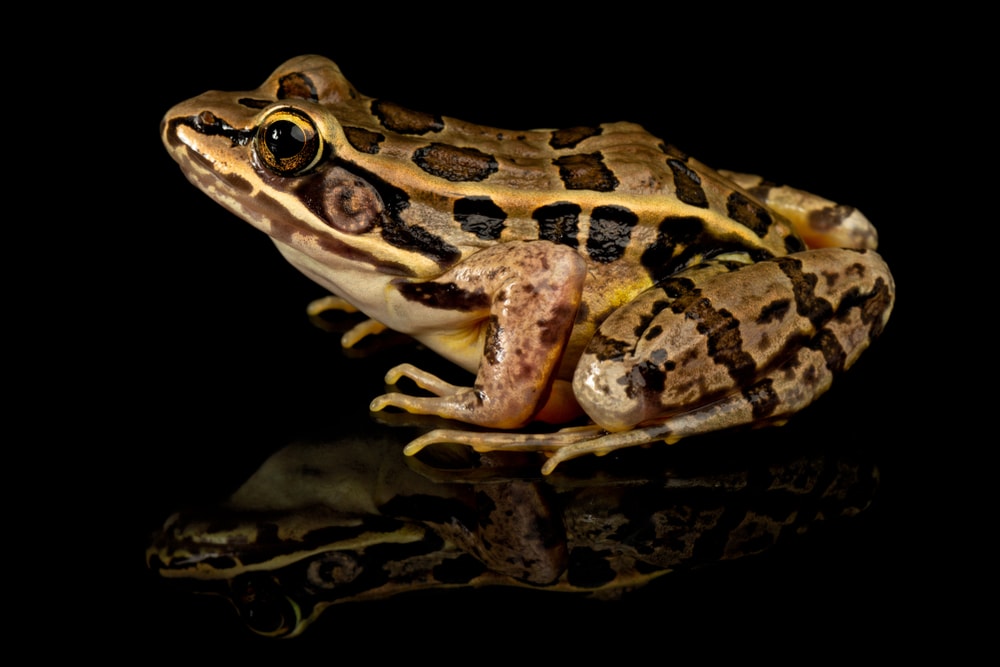
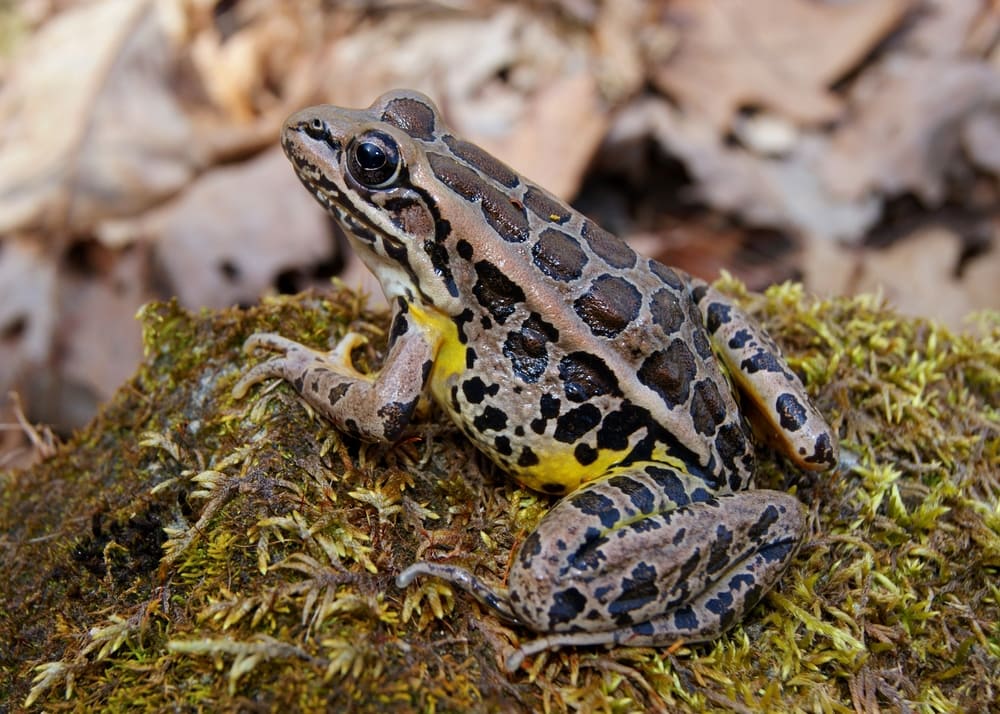
The Pickerel Frog is a large frog that reaches 4 inches (7.5 cm). This frog is usually dark-green, and it has two rows of dark squares on its back. You can differentiate this from the Leopard frog by the well-defined squares.
This frog has flashy yellow colors underneath the hind legs so that when it runs from predators, the colors will confuse them. Snakes avoid these frogs because they produce toxic skin secretions that are deadly to small animals and irritating for humans.
Males are recognized by their large thumbs and vocal sacs.
Their natural habitats include streams, ponds, lakes, and swamps with dense vegetation. The mating season starts in March and ends in May, with the female laying from 700 to 3,000 eggs. The tadpoles are herbivorous and carnivorous as adults. Pickerel frogs feed on invertebrates.
10. Northern Leopard Frog (Lithobates pipiens)
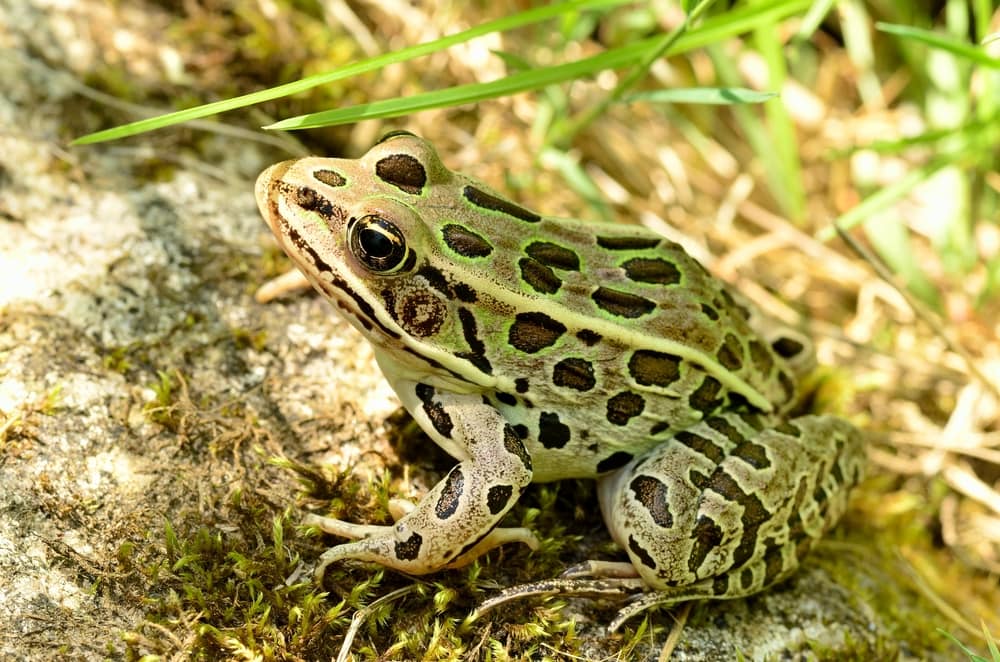
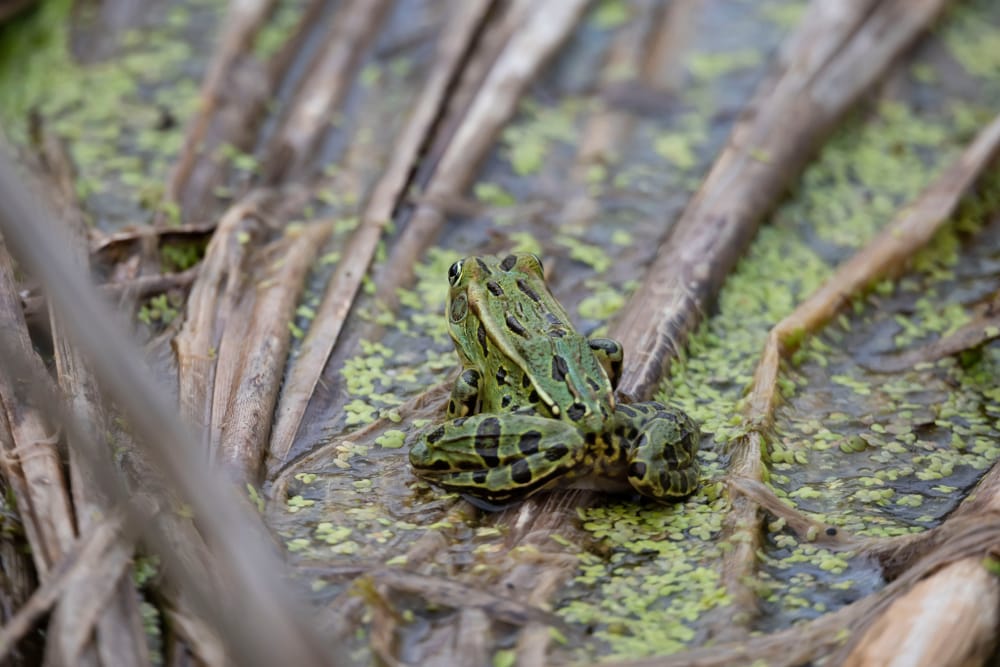
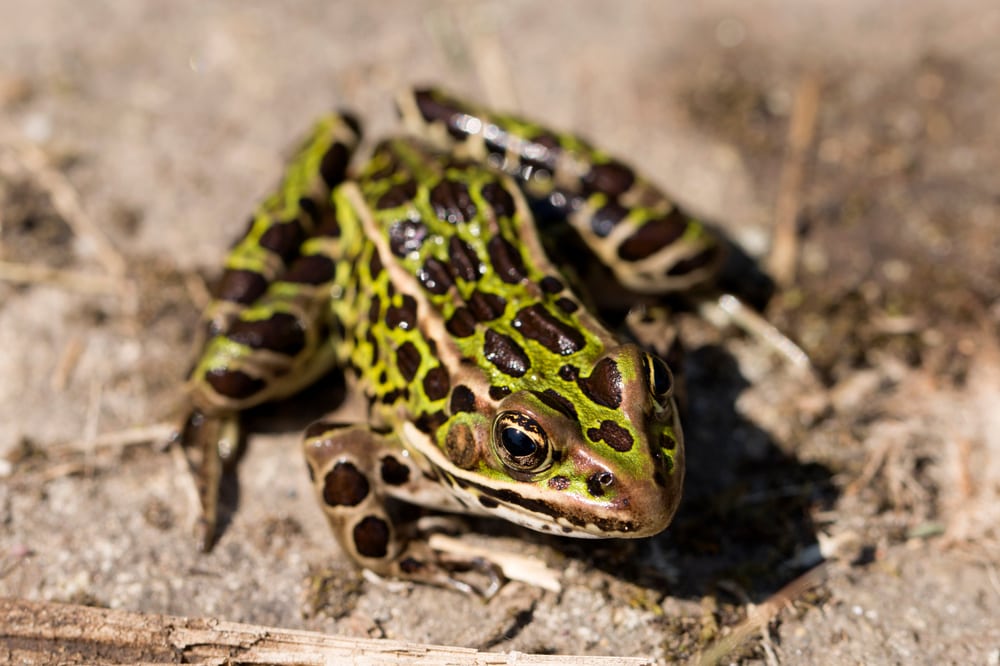
The Northern Leopard frog can be distinguished from the Pickerel frog by the shape of its spots. This frog has dark oval-shaped blotches on a green background. It usually reaches up to 5 inches (12.7 cm) and lives up to 4 years.
These frogs live all over North America except on the Pacific coast. As the majority of frogs in Michigan, they live near ponds, marshes and grasslands.
They eat whatever they can fit into their mouths. Frogs go for beetles, ants, flies, worms, and even their species. They are good hunters because they can leap and catch their prey with their sticky tongues. These frogs are not poisonous, so animals usually hunt them. Their predators are raccoons, birds of prey and snakes.
The mating season starts from March until June and the male frog will make a snore-like sound to attract females.
11. Boreal Chorus Frog (Pseudacris maculata)
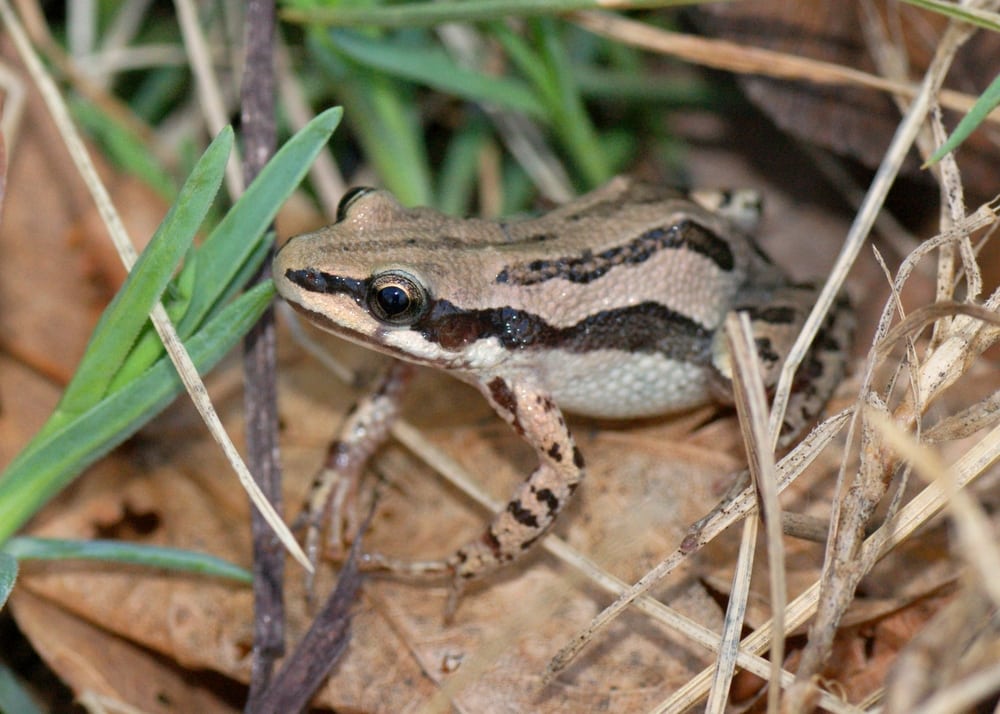
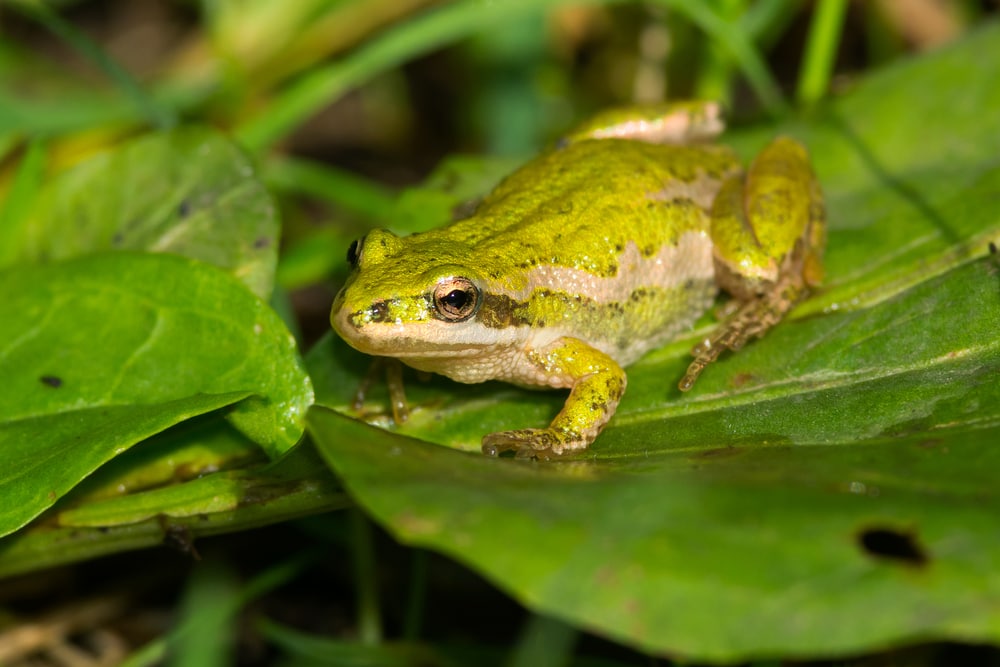
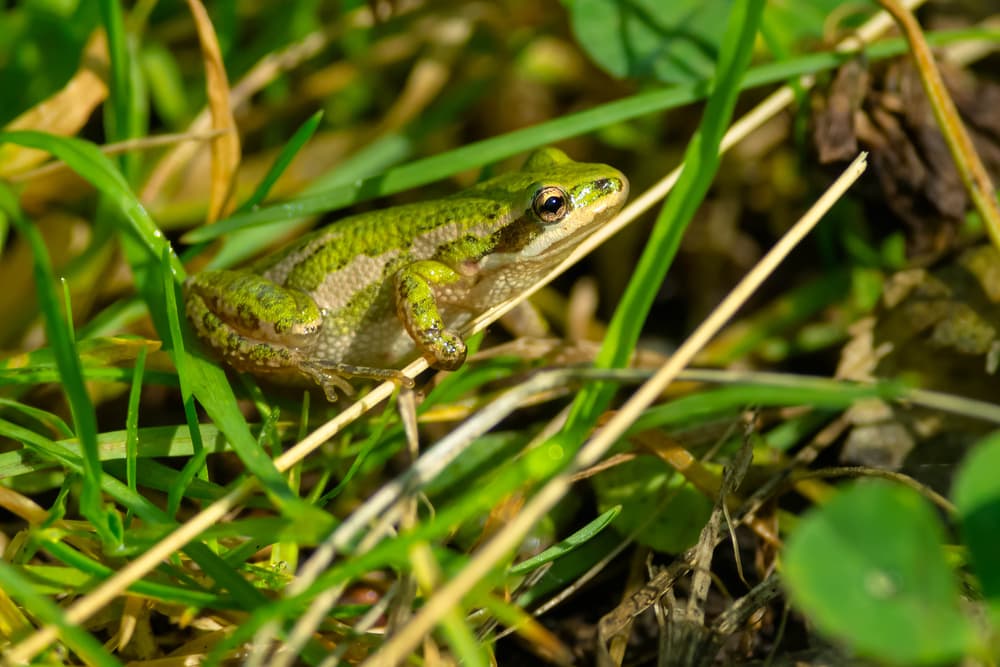
The Boreal Chorus frog is uncommon in Michigan, found only on Isle Royale, Lake Superior. It is a small frog, and the adult one goes up to 1.5 inches in length ( 3.8cm). Its colors can be reddish, brown, tan or gray, with three dark stripes on its back.
This species mates in small pools formed by rain. Their breeding call sounds like a “ cree-ee-ee-eek” sound.
They usually spend their year around the breeding ground, and they even hibernate there during the winters, beneath logs or rocks.
This species is listed as a Special Concern because it is rare, however, it is not legally protected.
12. Western Chorus Frog (Pseudacris triseriata)
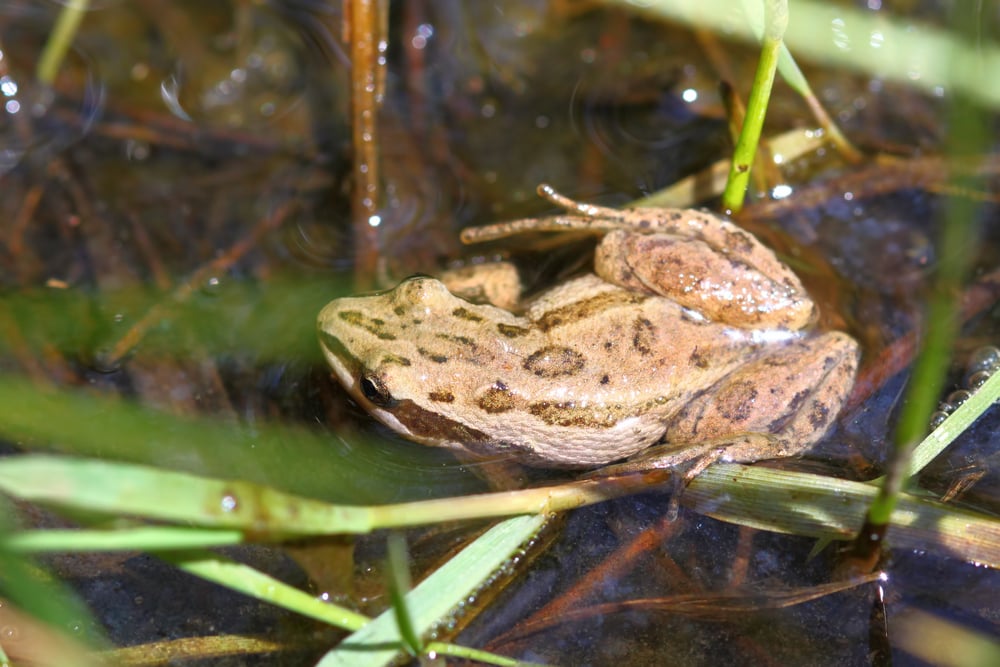
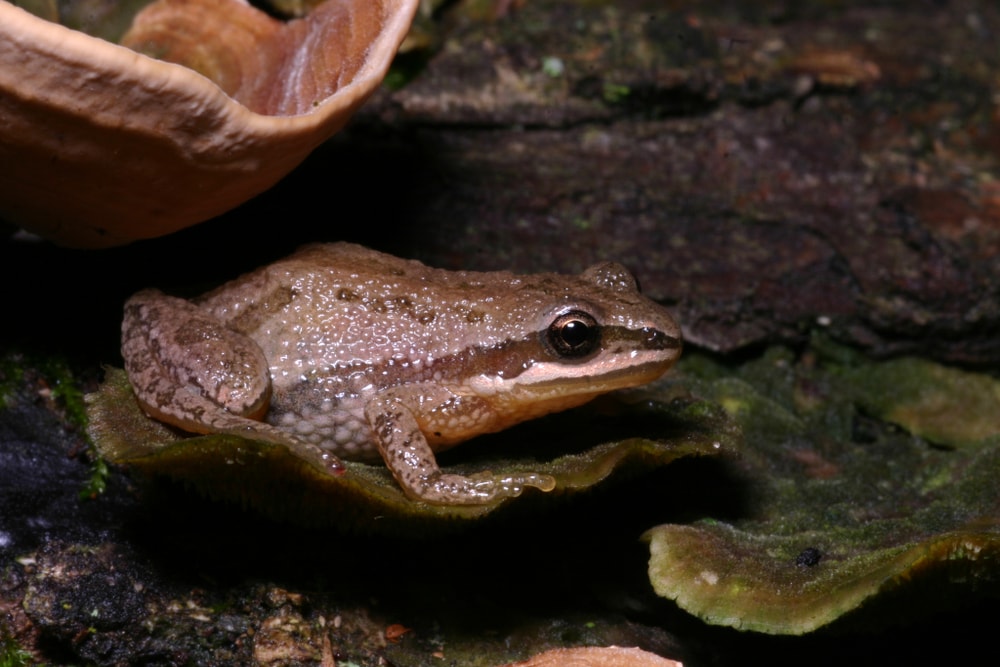
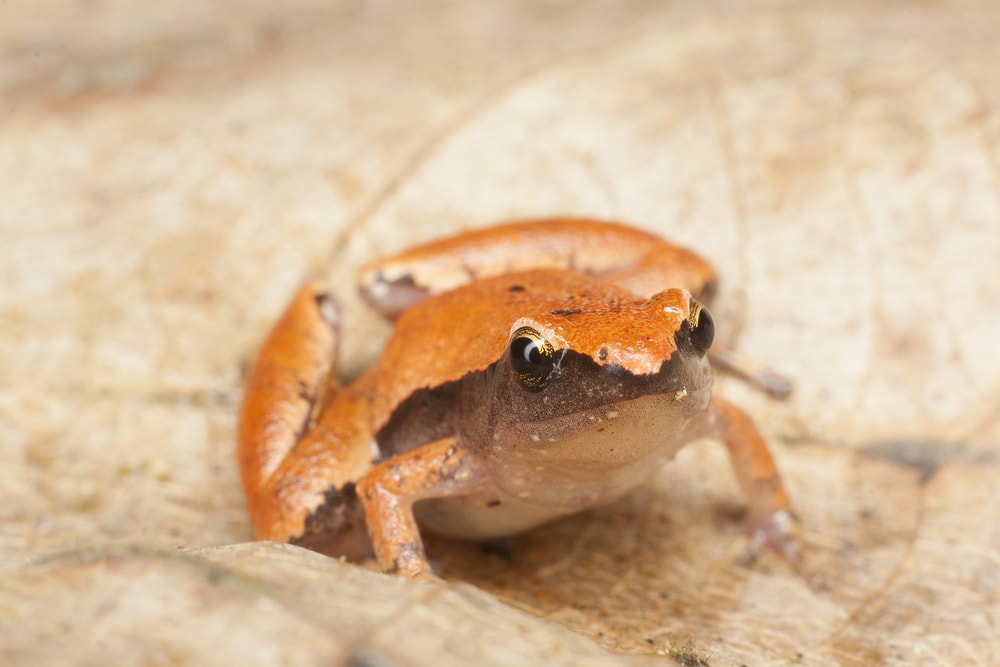
The Western Chorus frog looks very similar to the Boreal Chorus frog. However, the latter lives in only one place in Michigan. The Western Chorus also has longer hind legs than the other one.
This species is a small-sized frog, up to 1.5 inches ( 4cm), and has smooth skin that can be green, grey or brown. Their natural habitats include open forests near woodland ponds. They can breed in any pond with at least 4 inches (10cm) of water. It means gravel pits, marshes and swamps.
When the mating season starts in the spring, you will be able to hear sounds like “creeeek” from male Western Chorus frogs.
These frogs hibernate beneath logs and have antifreeze glucose. They are also the first frogs to wake up during spring for the mating season that starts in March.
Their diets consist of small insects, spiders, flies, moths and ants. They have many predators like raccoons, herons and snakes, while salamanders eat the tadpoles.
13. Fowler’s Toad (Anaxyrus fowleri)
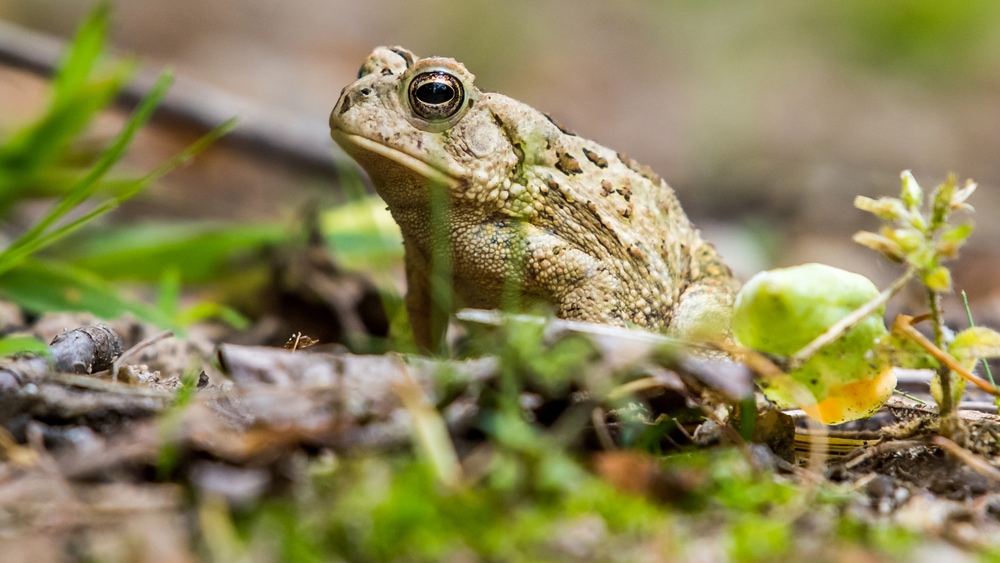
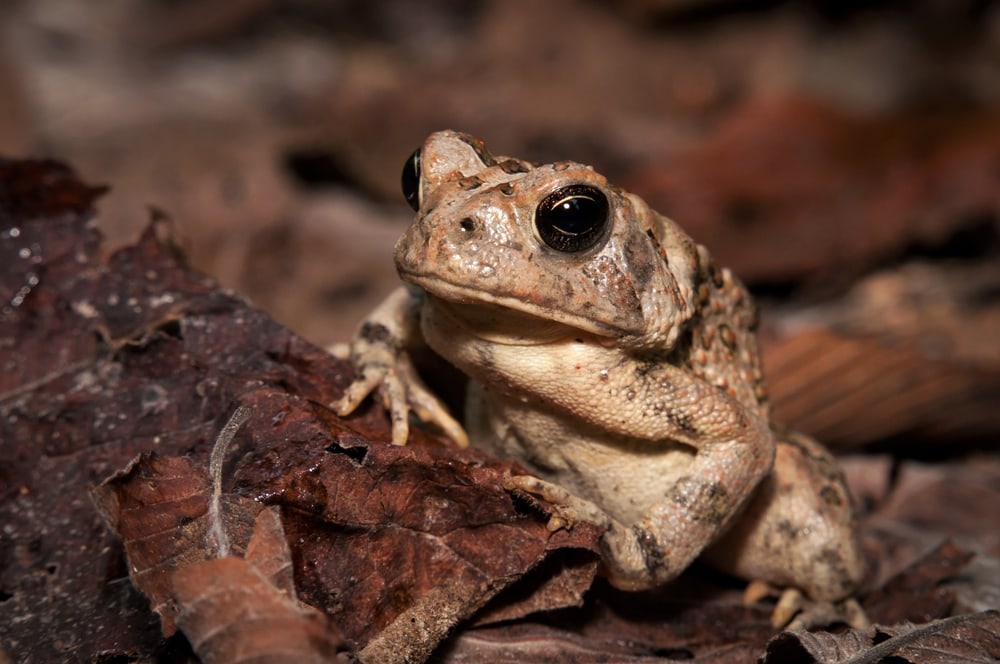
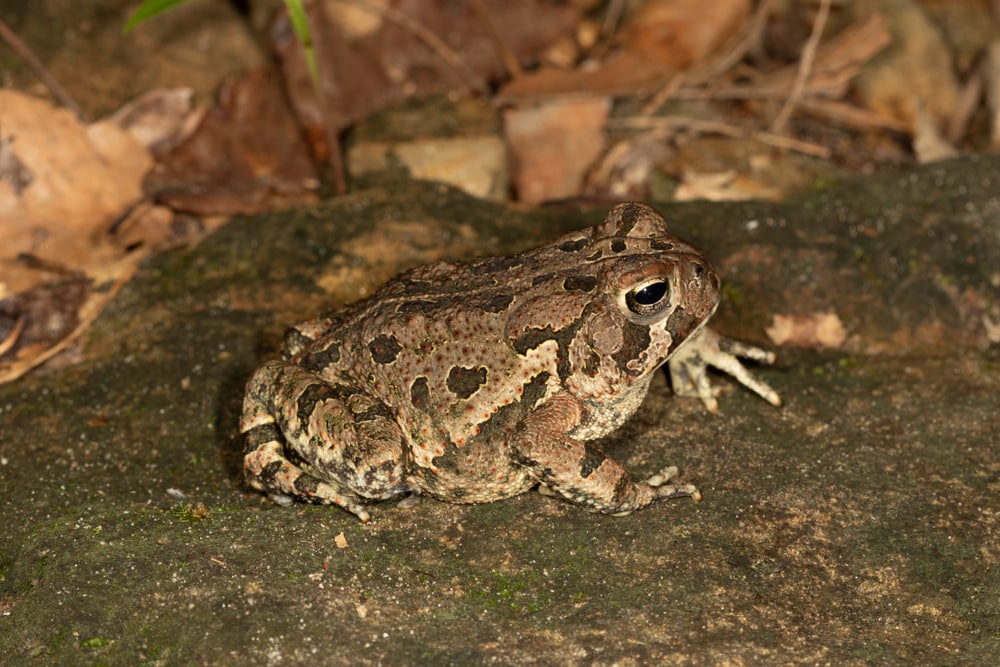
Fowler’s toad has dry, bumpy skin with short legs that can not jump. They are a small species, reaching up to 2.3 inches (7.5 cm), and can live up to 5 years. They are usually brown or grey, with a light stripe down their back.
These toads live in forests near bodies of water. Their natural habitats include marshlands, flood plains, and river valleys. Fowler’s toads are terrestrial and nocturnal. They are the most active during summer evenings.
The breeding season starts with the mating calls that sound like very harsh screams. They breed from March to June, and the female lays up to 25,000 eggs.
Their diet includes insects and other invertebrates, while their predators are birds and snakes. Fowler’s toad is under concern because of habitat loss.
14. Eastern American Toad (Anaxyrus americanus americanus)
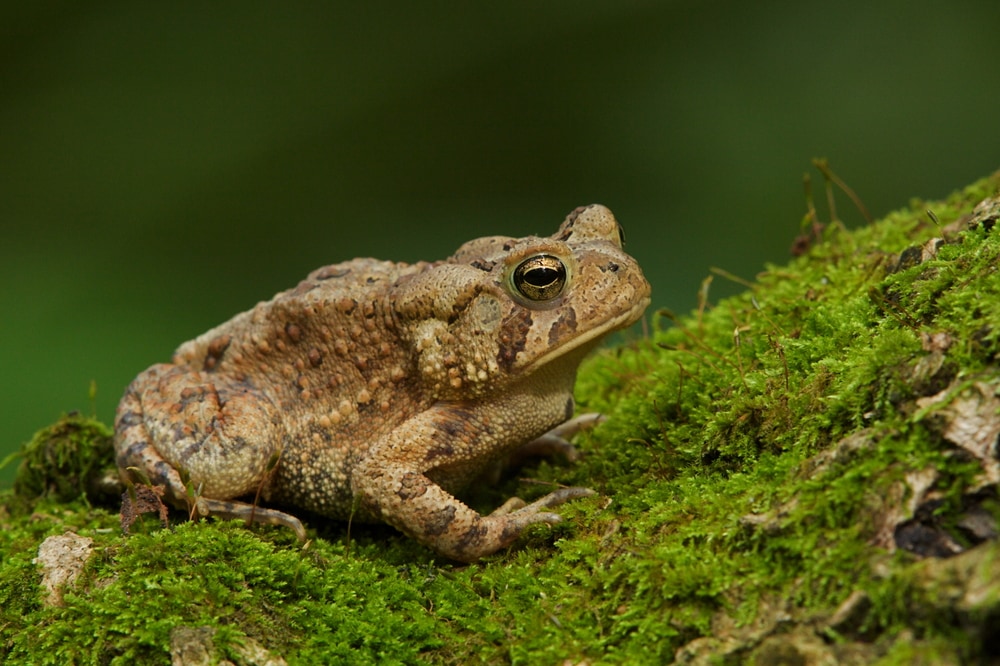
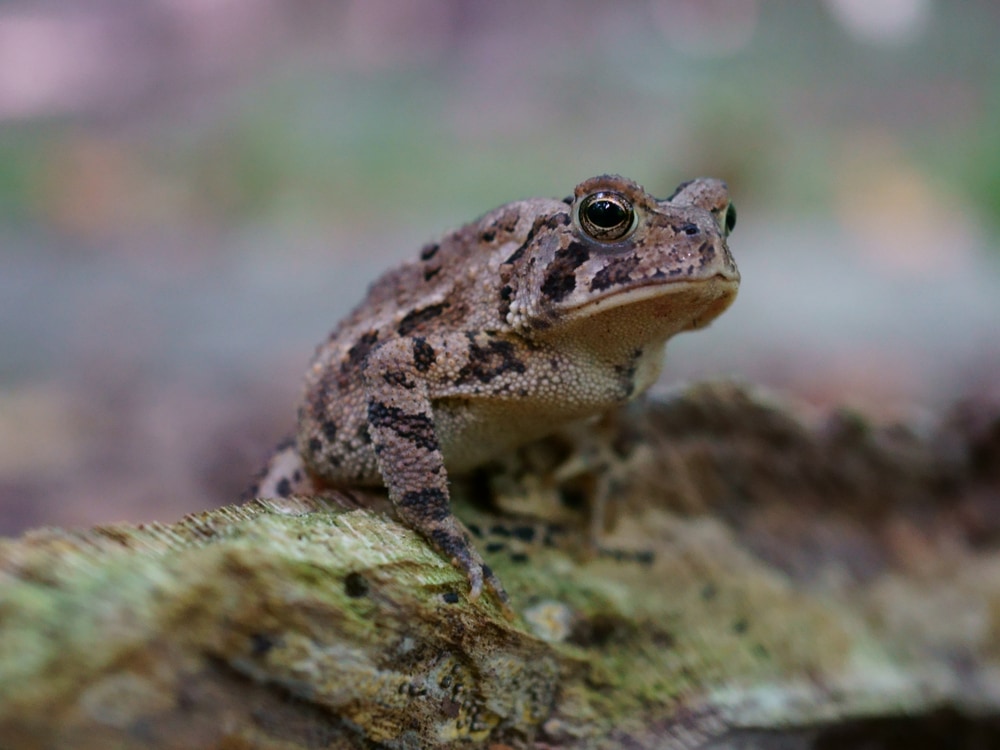
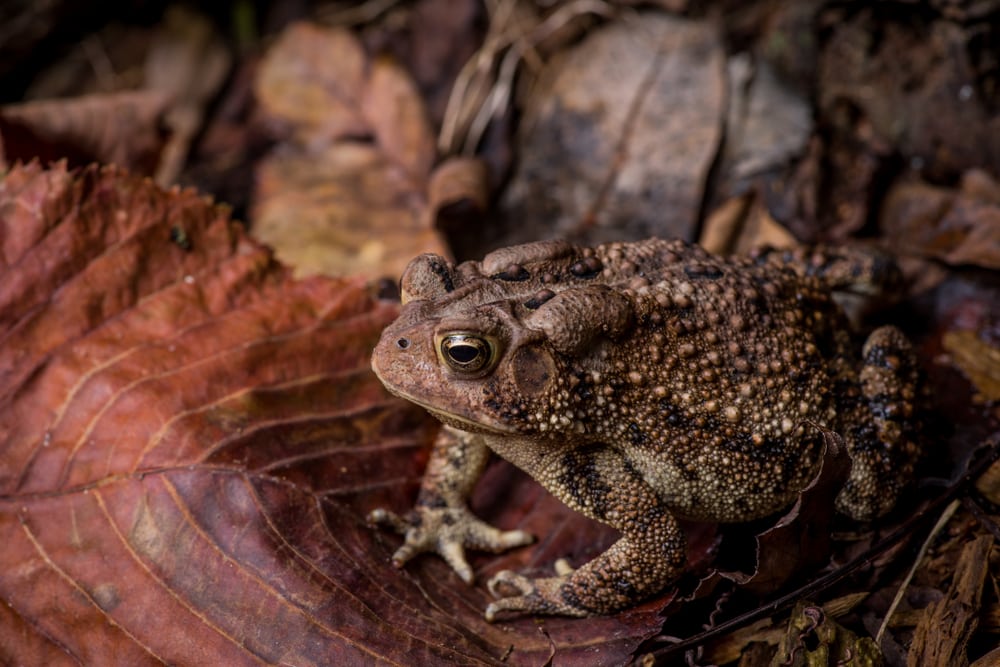
The Eastern American Toad has short legs and warts on its skin. It is a medium-sized toad that reaches up to 3.5 inches (8.9 cm) and can live up to 10 years under ideal conditions. Their skin color is usually a shade of brown, and their warts can be red and yellow.
This frog has many glands that contain a toxic fluid that can make many animals sick. Their poison is an excellent defense mechanism against predators. For humans, the poison is harmful if it is swollen or gets in contact with the eyes.
This toad has four fingers on its front legs and five webbed fingers on its hind legs. They can change skin color if they get stressed, the temperature is too low, or the humidity is too high. You can distinguish males from females by their throats. Males have darker throats, while females spot whiter ones.
The ideal habitats for American toads are the ones with semi-permanent freshwater ponds or pools. They can adapt to any environment, and you can spot them in forests and backyards.
The breeding season starts in March and ends in July. The males arrive at the breeding ponds and start their mating calls.
The female will lay from 4,000 up to 8,000 eggs, and they hatch in almost 12 days. Tadpoles transform into adults in almost 70 days.
The American toads are carnivores and eat insects, snails, beetles, slugs and earthworms. Their main predators are snakes.
You may also like: The 9 Different Types Of Hawks In Michigan (ID Guide, Pics And Facts)
The frog’s role in the Ecosystem
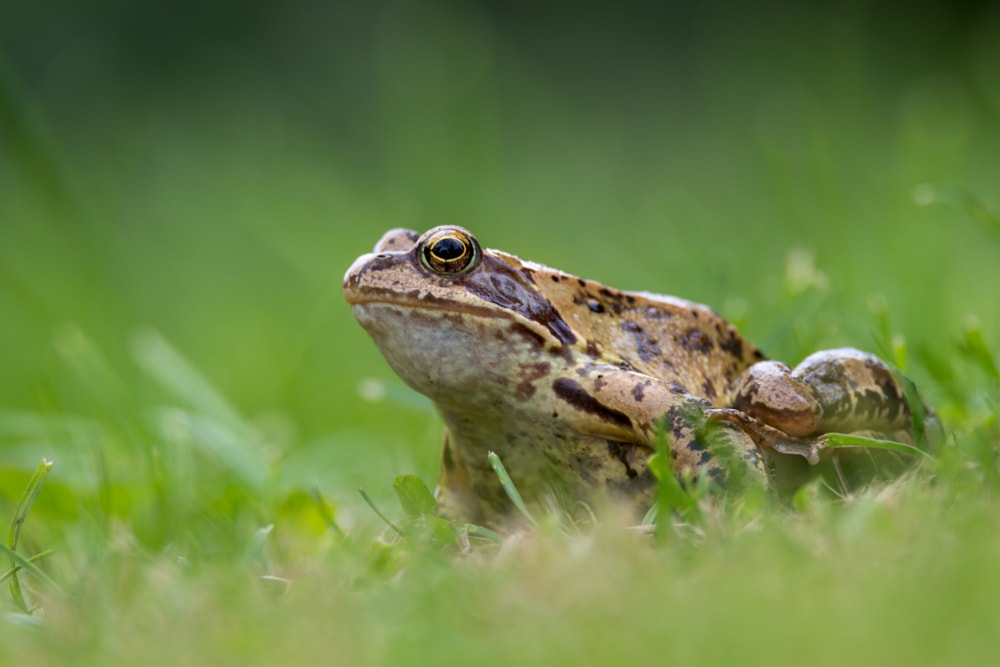
Frogs eat a lot of insects, so they help keep the insect population in check. They also support other animals by being their prey.
The Northern Peeper helps control the ratio of mosquitos in the areas they live.
Frogs are beneficial for flower gardens because they eat harmful plant insects and gastropods. Having frogs in your garden means fewer pesticides because they will eat insects, slugs and snails.
The decline of frog species speaks about the harm being done to their natural environment. If their number declines, it means their habitat has been polluted or destroyed.
You May Also Like: 10 Amazing Types Of Turtles In Michigan (ID Guide And Photos)
Cultural References: Myths and Legends
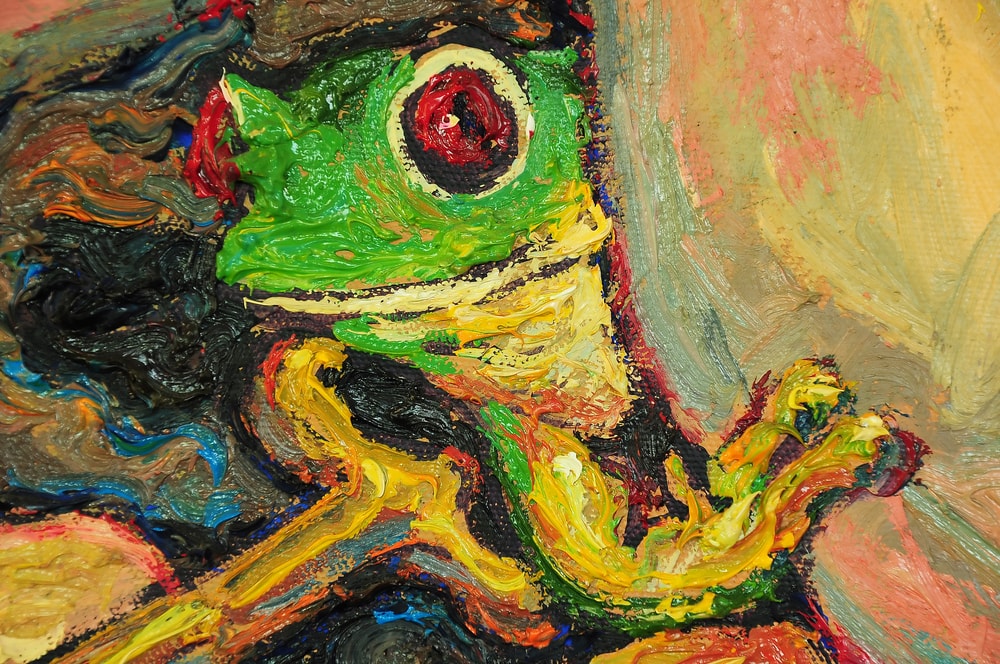
Chinese and Japanese Legends
In ancient Chinese legends, the toad is considered the trickster that can use spells and escape anytime it wants. It also keeps very powerful secrets, like the secret to immortality. Legends speak of a man called Liu Hai and his three-legged toad, Ch’an Chu. The man wanders the country with his companion while he learns the secret of immortality.
The Japanese have a similar legend with another wanderer called Kosensei. He is an old man with a warty face and a toad as a companion. This toad teaches him the secrets to eternal life. These Asian legends say that the secret to immortality lies in the fungus growing from the toad’s head.
You May Also Like: 20 Most Important Fish In Lake Michigan: Native And Introduced
FAQ
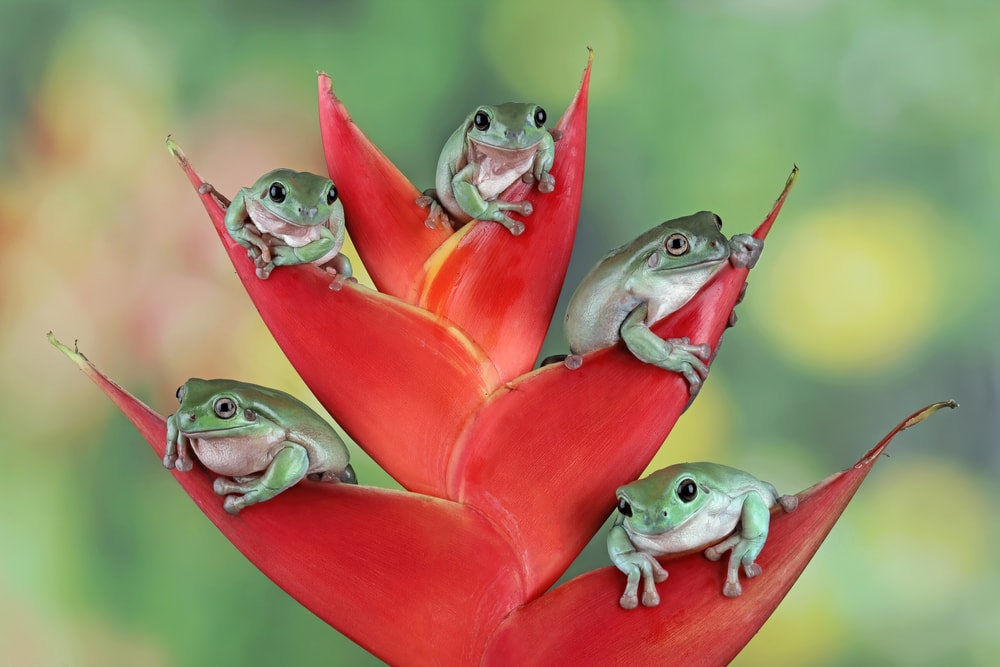
What is the most common frog in Michigan?
The most common frog in Michigan is the Northern Spring Peeper. It appears all over Michigan near marshy woods, swamps and ponds.
Are there poisonous frogs in Michigan?
There are two poisonous frogs in Michigan: the Eastern American and Fowler’s toad. Both frogs aren’t lethal to humans and are only harmful to their predators. Their glands produce a steroidal venom called Bufotoxin which can trigger cardiac arrest or seizure. For humans, it can irritate the eyes and nose. Do not let your pets chase these frogs, as they get affected by the poison.
Can you get warts from toads?
This is an old urban legend. In reality, you cannot get warts from toads. The HPV virus causes warts, and it can only be carried by humans. This age-old myth started because toads have warty, bumpy skin, and at one time, people considered them contagious.
You may also like:
Discover the different species found in Michigan here:

Fish In Lake Michigan | Snakes In Michigan | Turtles In Michigan | Woodpeckers In Michigan | Michigan Water Snakes | Hawks In Michigan | Michigan Birds | Owls In Michigan








